AGRICULTURAL SUPPLIERS FOOD SAFETY MANUAL


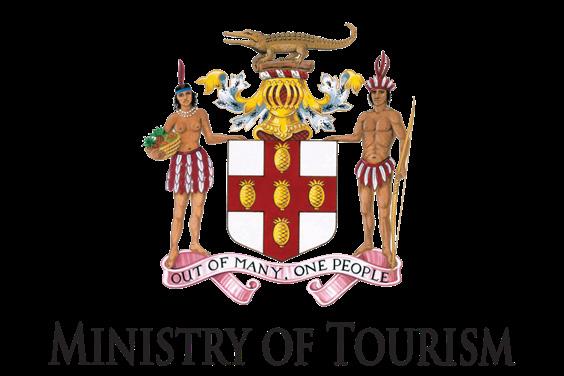
TOURISM LINKAGES NETWORK, A DIVISION OF THE TOURISM ENHANCEMENT FUND AGRICULTURAL SUPPLIERS FOOD SAFETY MANUAL DRAFT
Copyright © Tourism Enhancement Fund
October 2021
All rights reserved, Tourism Enhancement Fund. This document must not be reproduced without the permission of the Tourism Enhancement Fund. This document and any portion therein must neither be reproduced, stored in a retrieval system or transmitted in any form or by any means, electronic or mechanical nor must it be photocopied, recorded without the prior permission of the Tourism Enhancement Fund.
This manual was commission by the Tourism Enhancement Fund through the Tourism Linkages Network (TLN) and written by Aisha Bailey, PhD.
APA Citation
Tourism Enhancement Fund. (2021). Agricultural Suppliers Food Safety Manual. Tourism Enhancement Fund. www.tef.gov.jm
DRAFT
TABLE OF CONTENTS 44 49 56 59 62 65 69 70 71 Appendices References Conclusion Farm/Business Management Emergency Planning Waste Management Traceability Storage and Transportation Harvesting and Handling 04 09 08 07 06 11 26 32 40 Water Worker Hygiene Cleaning and Sanitizing Introduction to Food Safety Introduction Terms and Definitions Abbreviations Acknowledgments Messages DRAFT
I congratulate the Tourism Enhancement Fund (TEF), a public body of the Ministry of Tourism, on completing yet another game-changing publication that will serve as a tool to develop the tourism industry even further. The Agricultural Suppliers Food Safety Manual, which focuses on food safety assurance throughout the Jamaican tourism food supply chain, will undoubtedly prove helpful in strengthening the linkages between the tourism and agricultural sectors.
It is specifically designed to help farmers, food processors, manufacturers, and distributors who supply the tourism industry, to enhance their food safety awareness and capacity. It will also facilitate the enforcement of food safety and sanitation standards and practices that promote the health and well-being of workers and visitors.
The manual is an output of the Tourism Linkages Network, a division of the TEF, which has been utilizing several creative
approaches to provide much-needed support to the agricultural sector, which supplies our tourism industry.
I am very proud of the work being done by the entire team at the TEF, including the Tourism Linkages Network. The Network has undoubtedly stuck to their mandate of increasing the consumption of goods and services that can be competitively sourced locally. They have also continued to implement initiatives that seek to create employment as well as generate and retain more of the country’s foreign exchange earnings.
This manual is another creative and wellneeded initiative. Therefore, I commend the TEF and the Tourism Linkages Network for doing the research required to complete and publish this important document.
I encourage all food suppliers that serve the local hospitality industry to pay close attention to the details outlined in this manual. This will enable you to better meet the sector’s needs and continue earning from this very lucrative and important industry, which is the driving force behind the recovery of Jamaica’s economy.
Hon. Edmund Bartlett, CD, MP Minister of Tourism

4 DRAFT
TOURISM LINKAGES NETWORK, A DIVISION OF THE TOURISM ENHANCEMENT FUND
AGRICULTURAL
SUPPLIERS FOOD SAFETY MANUAL
The publication of the Agricultural Suppliers’ Food Safety Manual is another important deliverable and milestone in the multifaceted and long term journey being pursued by the Tourism Linkages Network (TLN), which is mandated by the Ministry of Tourism to ensure the deepening of economic and social linkages between Jamaica’s tourism sector and the productive sectors, as well as the local communities in and around the major tourism plants.
With the tourism sector already being a major user of locally grown agricultural produce, the TLN has taken the view that we cannot be satisfied with this but take a catalytic approach to building stronger linkages between small, medium and large farmers, giving them as seamless a connection with the buyers in the tourism sector. Even with generally high quality produce, the need was identified for the formalization of internationally accepted standards of traceability and phytosanitary
principles all the way through the farm-totable value chain.
The TLN is extremely proud that this manual was developed with critical input and endorsements from the Ministry of Tourism, Ministry of Health and Wellness, Rural Agricultural Development Agency, Bureau of Standards, Jamaica Hotel and Tourism Association etc. Agricultural stakeholders which cover Farmers, Agricultural Processers, Manufacturers, Hotels, Restaurants, Students, Teachers etc., now have a single and comprehensive food safety manual for use as both a reference guide and teaching tool, further ensuring greater safety standards across Jamaica’s food supply chain.
Wayne Cummings
Chairman, Tourism Linkages Network, Agricultural Technical Working Group

5
FUND AGRICULTURAL
FOOD SAFETY MANUAL DRAFT
TOURISM LINKAGES NETWORK, A DIVISION OF THE TOURISM ENHANCEMENT
SUPPLIERS
ACKNOWLEDGMENTS
The Tourism Enhancement Fund through the Tourism Linkages Network would like to extend its gratitude to all the stakeholder groups that accommodated consultation and provided feedback throughout the development of the Tourism Agricultural Supplier Food Safety Manual for the Jamaican Agriculture and Manufacturing Sector. Specifically, the following are acknowledged for the contribution toward the preparation of this document.
Mr. Collin Cooper - Food Safety and Protection Specialist, Ministry of Health and Wellness
Mr. Akenio Patterson - Standards Development Officer, Bureau of Standards
Ms. Hillary Rochester McIntosh - Food Safety Manager, Round Hill Hotels and Villa
Mr. Carlton Douglas - Marketing Officer, Rural Agricultural Development Authority (RADA)
Mr. Richard Guscott - Farmer
Mr. David Atkinson - Farmer
Ms. Maylin Rojas - Purchasing Manager, Iberostar Hotels and Resorts
Mr. Joseph Charlebois - Operations Manager, Glastonbury Purveyor Company
Ms. Marina Young - Principal Director, Technical Services, Rural Agricultural Development Authority (RADA)
Ms. Simara Howell - Executive Director, Jamaica Manufacturers and Exporters Association
Dr. Osbil Watson – Chief Veterinary Officer, Veterinary Services Division, Ministry of Agriculture
Mrs. Sanniel Wilson-Graham – Chief Plant Quarantine Officer Plant Quarantine and Produce Inspection Branch, Ministry of Agriculture and Fisheries
TOURISM LINKAGES
THE
FUND AGRICULTURAL SUPPLIERS FOOD
MANUAL 6 DRAFT
NETWORK, A DIVISION OF
TOURISM ENHANCEMENT
SAFETY
ABBREVIATIONS
TAS Tourism Agricultural Suppliers
FSMS Food Safety Management System
HACCP Hazard Analysis and Critical Control Points
GMP Good Manufacturing Practices
GFP Good Farming Practices
GAP Good Agricultural Practices
GHP Good Handling Practices
IPM Integrated Pest Management
CIP Cleaning in Place
QA Quality Assurance
QC Quality Control
ISO International Organization for Standardization
BSJ Bureau of Standards Jamaica
CCP Critical Control Point
CP Control Point
FAO Food and Agricultural Organization
MRL Maximum Residual Level
PHI Post Harvest Indicator
FIFO First in First Out
FEFO First Expire First Out
CAP Corrective Action Plan
GMO’s Genetically Modified Organisms
FST Food Safety Team
PPE Personal Protective Equipment
MDA Ministries, Departments and Agencies of Government
TOURISM LINKAGES NETWORK, A DIVISION OF THE TOURISM ENHANCEMENT FUND AGRICULTURAL SUPPLIERS FOOD SAFETY
7
DRAFT
MANUAL
TERMS AND DEFINITIONS
FOOD
Any substance, whether processed, semiprocessed or raw, which is intended for consumption, and includes drink and any substance which has been used in the manufacture, preparation or treatment of “food” but does not include cosmetics or tobacco or substances used only as drugs (ISO22000:2018).
FOOD CHAIN (FARM TO FORK)
Sequence of the stages in the farming / production, processing, distribution, storage and handling of a food and its ingredients, from primary production to consumption. It includes farmers, processors, traders, transporters, storage, and warehousing facilities, distribution, and final consumption. (ISO22000:2018, FAO)
FOOD SAFETY
Assurance that food will not cause an adverse health effect for the consumer when it is prepared and/or consumed in accordance with its intended use (ISO22000:2018).
FOOD SAFETY HAZARD
Any biological, chemical, or physical agent in food with the potential to cause an adverse health effect (ISO22000:2018).
FOOD QUALITY
It is the combination of a product’s characteristics (nutritional values, taste, smell, odor, color, size etc.), based on customer requirements, legal requirements, derived from product composition (FAO).
TRACEABILITY
Ability to follow the history, application, movement, and location of food through specified stage(s) of production, processing, and distribution.
HAZARD ANALYSIS
It is the process of collecting and evaluating information on hazards, and conditions leading to their presence, to decide which are significant for food safety and should therefore be addressed in the HACCP plan.
CLEANING
Removal of dust, debris and accumulated materials on food handling equipment, machines, containers, areas using physical or mechanical means.
SANITATION
Removal of biological hazards i.e., microorganisms from food handling equipment, containers, machines, areas using disinfects or sanitizing agents like detergents, temperatures, chlorine, acids, caustic etc.
CRITICAL CONTROL POINT (CCP)
Step in the process at which control measure(s) is (are) applied to prevent or reduce a significant food safety hazard to an acceptable level (ISO22000:2018).
CRITICAL LIMIT
Measurable value which separates acceptability from unacceptability. Critical limits are established to determine whether a CCP remains in control. If a critical limit is exceeded or not met, the products affected are to be handled as potentially unsafe products (ISO22000:2018).
AGRICULTURAL
8 DRAFT
TOURISM LINKAGES NETWORK, A DIVISION OF THE TOURISM ENHANCEMENT FUND
SUPPLIERS FOOD SAFETY MANUAL
1. INTRODUCTION
EXECUTIVE SUMMARY
The tourism food supply chain is a critical factor to the survival, growth, and sustainability of the tourism sector. With rising concerns related to food safety and associated risk of food-borne illness, control measures at all stages of the tourism food supply chain are necessary to ensure that final delivery of food to guests and the hospitality workers in Jamaica is safe.
“Farm to Fork Food Safety” principles assure the safety of food through all stages of the supply chain i.e., from farm, through processing till delivery of finished food products to consumers. This Tourism Agricultural Supplier Food Safety Manual focuses on food safety assurance throughout the Jamaican tourism food supply chain starting with fruits, vegetables and animal products at farms to any intermediary processors, storage, handlers, and delivery of final food products.
This manual focuses on specific food safety hazards - physical hazards, chemical hazards, and biological hazards - and how tourism stakeholders along the value chain can mitigate these risks posed to food supply.
Good agricultural practices are discussed in detail to control and manage food safety hazards at farms currently supplying Jamaica’s hospitality sector. These include, selection of farming sites, seeds, cleaning and sanitation activities, employee facilities, pest management, water resources, pre and post harvesting, storage, handling, and packaging.
However, producers represent only one segment of the food supply chain. Without managing food safety in other segments such as food processors, storage and handling, manufacturing, and distributions, it is not possible to maintain food safety. This manual therefore discusses best practices, such as Hazard Analysis and Critical Control Point (HACCP) and Good Manufacturing Practices (GMP), to effectively manage and control food safety hazards.
TOURISM LINKAGES NETWORK, A DIVISION OF THE TOURISM ENHANCEMENT
9
FUND
DRAFT
AGRICULTURAL SUPPLIERS FOOD SAFETY MANUAL
PURPOSE OF THE MANUAL
The Agricultural Suppliers Food Safety Manual is an information resource to help increase the food safety knowledge and capacity of farmers, processors, manufacturers, and distributors which supply the tourism sector in Jamaica. The manual will enforce food safety and sanitation standards and practices that support the health and wellbeing of tourism workers and guests. Implementation of these recommendations will ensure compliance/alignment with relevant national and international guidelines/ authorities, such as the Bureau of Standards Jamaica and ISO22000:2018 Food Safety Management System.
SCOPE OF THE MANUAL
This Tourism Agricultural Supplier Food Safety Manual represents a comprehensive food safety approach applicable to all key processes and activities performed at the farm level. It also provides coverage of standards related to the processing, manufacturing, and distribution to ensure food remains safe from “Farms to Fork”. It provides general guidelines applicable to all farms (plants and animals), food processors, handlers, manufacturers, and distributors involved in the Jamaican tourism food supply chain. The manual
addresses the best practices related to the production and delivery of fruits, vegetables, ground produce, meat, eggs, and processed foods to include ingredients and inputs thereof.
Food safety governance in Jamaica is a multisectoral process, involving multiple parties throughout government and international bodies. This manual is aligned to following guidelines providing a single synthesis of best practices in food safety management practices for the tourism industry.
• A Guide to Good Manufacturing Practices (GMs) in Packing Establishments
• Bureau of Standards Jamaica (Appendix 1)
• Codex Alimentarius
• Food and Drug Act
• Food and Drug Administration Food Safety Modernization Act
• Good Manufacturing Practices
• Health and Food Safety Manual for the Hospitality Industry (1998)
• International Standards Organization Food Safety Management System (ISO 22000:2018)
• Ministry of Agriculture Good Agricultural Practices
• National Food Safety Policy
• Public Health Act
• The Agricultural Produce Act
• The Processed Food Act
HOW TO USE THE MANUAL
The manual is to be used by farmers, purveyors, importers, manufacturers and other suppliers of agricultural products and/or processed foods to the local hospitality sector as a guide in the development of internal procedures and systems for food safety. The manual is also to be used by tourism establishments, such as hotels, restaurants, and tour operators, during the procurement/ sourcing process in assessing the ability of the supplier to deliver safe food.
This manual is divided into 10 key technical sections that allow for easy use and reference by the user. These areas include comprehensive approaches that can be applied to the relevant operations within the food suppliers’ business. The sections are as follows:
• Food Safety Hazards
• Good Hygiene Practices (GHP)Cleaning and Sanitizing
• Worker Hygiene
• Water
• Harvesting and Handling
• Storage and Transportation
• Traceability
• Waste Management
• Emergency Planning
• Farm Management TOURISM LINKAGES NETWORK, A DIVISION OF THE TOURISM ENHANCEMENT FUND
10 DRAFT
AGRICULTURAL SUPPLIERS FOOD SAFETY MANUAL
2. INTRODUCTION TO FOOD SAFETY
11
LINKAGES NETWORK, A DIVISION OF THE TOURISM ENHANCEMENT FUND AGRICULTURAL SUPPLIERS FOOD SAFETY MANUAL DRAFT
TOURISM
WHAT IS FOOD SAFETY
PRODUCERS
Input suppliers and farmers at base of the supply chain
PROCESSORS
Including manufacturers that add value to foods
DISTRIBUTORS
Logistics and transportation of food
FOOD & BEVERAGE SERVICE PROVIDERS

Tourism based products and services
CONSUMER
Tourists that consumes or purchases food
Food safety is the assurance that food will not cause an adverse health effect for the consumer when it is prepared and/or consumed in accordance with its intended use. (ISO22000:2018). Safe food is food which is free from all types of hazards and contamination. TOURISM LINKAGES NETWORK, A DIVISION OF THE TOURISM ENHANCEMENT FUND
SUPPLIERS FOOD SAFETY MANUAL
12 DRAFT
AGRICULTURAL
THE TOURISM FOOD SUPPLY CHAIN
The tourism food supply chain is the entire process of producing, making, delivering and, selling foods to the tourism industry. A typical food supply chain or food system refers to the processes which moves food from a farm (producer) to the table (consumer). The processes are systematic in nature and include production, processing, distribution, consumption, and disposal.
Most common stages of a wide food supply chain include:
• Food producers / growers i.e., farmers.
• Food transporters / logistics
• Food processors/manufactures
• Storage and warehousing
• Wholesalers and retailers
• Consumers / tourists / tourism industry
Food waste collection and disposal
1 https://orgprints.org/id/eprint/28858/1/evidence-document-sfsc-cop.pdf
The food supply chain can also be in the form of a Short Food Supply Chain Model1. It is the smallest food supply chain with few steps or intermediaries involved. This supply model exists within the tourism food supply chain and involves farmers that sell their products to consumers the following ways:
• Farmers
• Markets
• Farm shops
• Community-supported shops
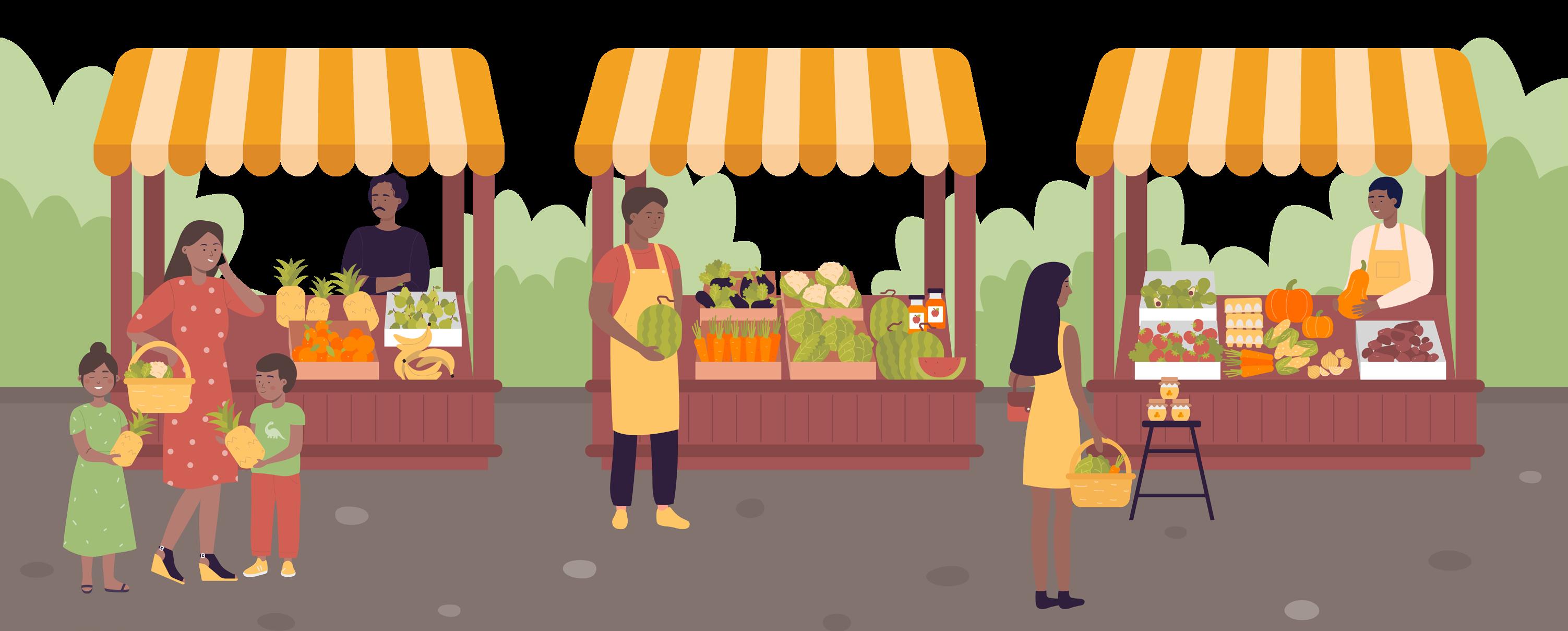
• Food festivals and fairs
• Supermarkets
• Specialist shops
• Farm based delivery schemes
• Hotels, catering providers, restaurants etc.
13
LINKAGES NETWORK, A DIVISION OF THE TOURISM ENHANCEMENT FUND AGRICULTURAL SUPPLIERS FOOD SAFETY MANUAL DRAFT
TOURISM
THE IMPORTANCE OF FOOD SAFETY IN THE TOURISM FOOD SUPPLY CHAIN
Food Safety is of utmost importance for the tourism food supply chain. Food safety;
• Protects health of tourists and tourism workers by ensuring delivery of safe food.
• Provides competitive advantage to farmers to sell safe food to tourism establishments. Foods which are proven safe through food safety certifications are most widely accepted to markets and consumers, which results in a competitive advantage for the growers and sellers. It also rewards high value and price resulting in good profits.
• Protects Jamaica’s position as a premium destination for travelers.
• Reduces risk and liability within tourism establishments.
• Reduces the pressure/costs on the public health care system.
• Is helpful in minimizing food wastages through damages and contamination, thereby protecting the environment.
• Helps to reduce food recalls for manufacturers and processors.
• Promotes farmers and companies’ reputations and customer loyalty.
• Increases opportunities for export of locally produced agricultural products and processed foods.
LINKAGES
FUND AGRICULTURAL
FOOD
MANUAL 14 DRAFT
TOURISM
NETWORK, A DIVISION OF THE TOURISM ENHANCEMENT
SUPPLIERS
SAFETY
FOOD SAFETY HAZARDS
A food safety hazard refers to any agent with the potential to cause adverse health consequences for consumers. There are different types of food safety hazards which could contaminate food at farm level, during processing, manufacturing, or distribution. These hazards can be introduced accidentally or deliberately. These are classified as:
PHYSICAL HAZARDS
All foreign objects in food other than food are called Physical Hazards. They can cause choking, illness, or injury to consumers.
At farms, contamination from physical hazards can occur during production, harvesting and post-harvest handling, packing, processing, storage, and transportation.
COMMON PHYSICAL FOOD HAZARDS
GLASS, WOOD, PLASTIC, METAL, PAPER
» From equipment, containers, lights, fixtures, fittings used during harvesting, during processing and packing.
JEWELRY, WATCHES, BUTTONS, HAIRS, CLIPS, FALSE EYELASHES, FALSE NAILS, PPES
» From people involved in harvesting, handling, packing, processing, manufacturing of food.
STONES, SOIL, DEBRIS, WEEDS, SEEDS, STEMS, LEAVES
» During harvesting, dirty equipment, containers, and storage areas.
PESTS SUCH AS FLIES, BEETLES, WORMS, MOSQUITOES, COCKROACHES
» Improper packing, processing, manufacturing, storage, transportation facilities. Lack proper pest management practices. Poor cleaning and postharvesting practices.
15
ENHANCEMENT
AGRICULTURAL
FOOD SAFETY MANUAL DRAFT
TOURISM LINKAGES NETWORK, A DIVISION OF THE TOURISM
FUND
SUPPLIERS
CHEMICAL HAZARDS
Chemicals that contaminate food during harvesting, production, processing or packing, storage and distributions are chemical hazards. They can cause illness or death of consumers.
NATURAL TOXINS (E.G. ALLERGENS, MYCOTOXINS, ALKALOIDS, ENZYME INHIBITORS, AFLATOXINS, SCROMBOTOXINS)
» Can be naturally occurring. Can result from improper storage conditions i.e. high humidity, open storage of vegetables in sunlight.
OIL, GREASE, AND LUBRICANTS
» From machines/equipment used at farms, during harvesting, processing, manufacturing.
PESTICIDES
» Lack of awareness of farmers on specifications / limits.
» Pesticides exceeding maximum residual limit (MRL)residual.
» Use of inappropriate pesticides.
» Lack of testing and analysis before and during processing and manufacturing.
HEAVY METALS
» From irrigation water, soil and cleaning chemicals used during postharvest handling, processing, and manufacturing.
FERTILIZERS, SANITIZERS, PAINT, ADHESIVES
» Excessive use of fertilizers.
» From food contact by handlers.
» Paint from containers, walls etc. during storage.
FOOD ADDITIVES
» Sodium nitrate, carbides for ripening, oil, preservatives used in processing and manufacturing.
CLEANING CHEMICALS SUCH AS DISINFECTANTS AND DETERGENTS
» Residual from improper use and cleaning of equipment, tools and produce during harvesting, processing, manufacturing, packing, storage, and distribution.
AGRICULTURAL
16 DRAFT
TOURISM LINKAGES NETWORK, A DIVISION OF THE TOURISM ENHANCEMENT FUND
SUPPLIERS FOOD SAFETY MANUAL
BIOLOGICAL HAZARDS
Disease causing pathogens, bacteria, viruses, or parasites which can cause illness in consumers and spoil foods, fruits and vegetables are biological hazards.
BACILLUS CEREUS
» Found in potatoes, rice.
PARASITES (EG. PROTOZOA, FLUKES, TAPEWORMS, HOOKWORMS)
» Raw foods, animal vectors, feces, contaminated water, soil, food handlers
HEPATITIS (A, B, C)
» From human contact, fruits and vegetables contaminated by food handlers at farms and involved in processing and manufacturing operations, packing etc., contaminated water.
SALMONELLA
» Eggs, poultry, dairy products, and seafood.
ESCHERICHIA COLI (E. COLI)
» Raw meat, unpasteurized milk or juices, underground/well water.
CAMPYLOBACTER SPECIES
» Raw poultry, raw milk, raw beef, and water contaminated by animal feces.
STAPHYLOCOCCUS AUREUS
» Dairy products.
LISTERIA MONOCYTOGENES
» Raw milk, soft-ripened cheeses, and processed meats, but also in raw and smoked fish, poultry, fresh vegetables, and ice cream.
TOURISM LINKAGES NETWORK, A DIVISION OF THE TOURISM ENHANCEMENT FUND AGRICULTURAL SUPPLIERS FOOD SAFETY MANUAL
17
DRAFT
HACCP AT FARM, PROCESSOR AND MANUFACTURER LEVEL
HACCP (Hazard Analysis and Critical Control Points) is recommended to identify and manage possible food hazards at the farm or manufacturing level. It is a disciplined and systematic approach to the identification, prevention, and elimination of food safety hazards in farms, food handling sites, processing and production, packing, storages, distribution, and end use of product.
Tourism agricultural suppliers should implement HACCP to ensure that risks posed to food can be managed, monitored, and reduced. HACCP plans are beneficial to suppliers of the local tourism industry in the following ways.
• Increases customer and consumer confidence
• Improves efficiency during production
• Reduces loss of productivity due to spoilage and illness
• Reduced liability on the part of the suppliers
• Increase food quality and consistency
• Increases access to new markets and buyers
HACCP is implemented using the 7 principles (steps). They are as follows:
1. CONDUCT A HAZARD ANALYSIS
Identify different types of hazards and sources of hazards associated with a particular step in the food supply chain (such as dirt on produce or pesticide residue). Each hazard is evaluated based on likelihood of occurrence and its severity/impact on food safety (Table 1).
Table 1: Hazard Risk Analysis Matrix (Risk Score = Probability x Severity)
Likelihood
Hazards with high scores are managed through HACCP Plan and those with low scores are managed through Good Agricultural Practices (GAP) and Good Manufacturing Practices (GMP) and prerequisite programmes.
Severity 1 2 3 4 5 1 1 2 3 4 5 2 2 4 6 8 10 3 3 6 9 12 15 4 4 8 12 16 20 5 5 10 15 20 25
TOURISM LINKAGES NETWORK, A DIVISION OF THE TOURISM ENHANCEMENT FUND AGRICULTURAL SUPPLIERS FOOD SAFETY MANUAL 18 DRAFT
2. DETERMINE THE CRITICAL CONTROL POINTS (CCP’S)
Assign Critical Control Points (CCPs) to high score hazards to reduce their impact and probability to an acceptable level through some administrative and operational control measures. Critical Control Points are the final controls in the food supply chain where food safety hazards are controlled to eliminate them from food or reduce to an acceptable level (e.g. washing produce, using fertilizers according to manufacturer’s specifications).
3. ESTABLISH CRITICAL LIMIT(S)
Set critical limits to represent allowable tolerances for control points outside which results in contaminated (e.g. temperature at which produce must be kept after harvesting). Critical limits are based on R&D, internal data, or product specifications from local or international literature and can be quantitative or qualitative.
4. MONITOR CCP’S
Develop a system to measure and monitor the critical limit at each of the CCP (e.g. determine when and how often the temperature of storage facility must be monitored). These procedures are required to monitor performance of established CCP and to determine whether controls are working or not. The monitoring procedures are done through inspection, testing or measurements etc.
5. ESTABLISH THE CORRECTIVE ACTION
Establish procedures that should be followed when any change in monitoring of CCP’s is observed (e.g. disposing of spoiled produce which has been kept at too high a temperature). Such corrective actions remove unfavourable variations and bring back control points within an acceptable range. A thorough investigation into the cause of the variations must also be conducted to limit recurrence.
6. VERIFICATION OF HACCP PROGRAMME
Verify the HACCP program at regular frequencies to ensure that all activities and controls that determine the validity of the plan are working as intended (.eg. calibrating thermometers).
7. ESTABLISH DOCUMENTATION CONCERNING ALL PROCEDURES AND RECORDS
Maintain documented records of all activities so as to ensure accountability and traceability and that food supplies entering the tourism industry are produced safely (e.g. temperature logs for storage rooms).
TOURISM LINKAGES NETWORK, A DIVISION OF THE TOURISM ENHANCEMENT FUND AGRICULTURAL SUPPLIERS FOOD SAFETY MANUAL
19
DRAFT
Example Hazard Analysis and HACCP Plan
Scenario: A farmer in Portland supplies chopped callaloo to a large hotel in St. Ann to be used as a part of the breakfast menu. The Purchasing Department has asked the farmer to present a HACCP plan to demonstrate that he/she has the systems in place to produce and supply safe callaloo. This farmer sources water from a nearby river (downstream) and uses organic compost tea for fertilizer and uses Abamectin as an insecticide. Here is an example of a Hazard Analysis and HACCP plan by implementing the 7 principles of HACCP.

20 DRAFT
TOURISM LINKAGES NETWORK, A DIVISION OF THE TOURISM ENHANCEMENT FUND AGRICULTURAL SUPPLIERS FOOD SAFETY MANUAL
Table 2: Example of Hazard Analysis of Cultivated Callaloo (Based on the 7 Principles of HACCP)
Processing Step
Biological: Microorganisms from water used to moisten soil. Yes
Water from the river is accessed downstream of a squatting community along the river bed further upstream.
What Measures Can be Implemented to Prevent/ Eliminate/Reduce Hazard?
Water can be regularly tested to ensure it meets the coliform limits set by the National Planning and Environment Agency (NEPA).
Soil Preparation
Chemical: Oil from machinery No Visual inspection conducted, oil tank has an airtight seal.
Physical: Metal debris from fork, shovel, machinery etc.
Sowing Callaloo Seeds
Irrigation
Fertilizer Application
CCP
See CCP – Surface Water Testing
No Visual inspection of tools conducted to ensure no breaking fragments.
Chemical: Residual pesticide in seeds. No Supplier provides certificate of analysis with seeds
Biological: Microbial contamination from water. Yes
Water from the river is accessed downstream of a squatting community along the river bed.
Chemical: Chemical contamination from water. Yes Upstream, water is used for washing clothing.
Chemical: Fertilizer above maximum residual limit. No Only organic compost tea is used as fertilizer
Water can be regularly tested to ensure it meets the coliform limits set by the National Planning and Environment Agency (NEPA).
Water can be regularly tested to ensure it meets the nutrient limits set by the National Planning and Environment Agency (NEPA).
See CCP – Surface Water Testing
See CCP – Surface Water Testing
TOURISM LINKAGES NETWORK, A DIVISION OF THE TOURISM ENHANCEMENT FUND AGRICULTURAL SUPPLIERS FOOD SAFETY
Potential Food Safety Hazards Is this Hazard Likely to Occur? Basis
21
MANUAL DRAFT
Pesticide Application
Chemical: Pesticide above maximum residual limit. Yes
Pesticide used for treatment of beet Armyworm is always used/applied according to the manufacturer’s instructions.
Utilize pesticides according to manufacturer’s instructions and adhering to Pre-Harvest Intervals (PHI). Plants can be tested for regularly for pesticide residue.
Biological: Microbial contamination from farmer’s hands.
Harvesting
Washing
No
Strict hygiene regime and gloves used.
Cutting/ Trimming
Biological: Beet Armyworm Yes Current infestation by pests.
Physical: Soil, dust debris Yes Standard occurrence during harvesting.
Biological: Microbial contamination from water. Yes
Biological: Cross microbial contamination from equipment/ tools.
Water from the river is accessed downstream of a squatting community along the river.
Tools properly sterilized at the end of each use.
Utilization of approved insecticide Abamectin for young and older worms.
Utilization of produce wash to clean and sanitize produce. CCPProduce Washing
Water can be regularly tested to ensure it meets the coliform limits set by the National Planning and Environment Agency (NEPA).
See CCP – Surface Water Testing
No
Physical: Fragments from equipment and tools No Visual inspection of tools conducted to ensure no breaking fragments.
TOURISM LINKAGES
DIVISION OF THE
ENHANCEMENT FUND AGRICULTURAL SUPPLIERS FOOD SAFETY MANUAL 22 DRAFT
NETWORK, A
TOURISM
Packaging
Biological: Microbial contamination from food handler. No Strict hygiene regime and gloves used.
Biological: Microbial contamination from packaging (bags)
No
New fresh bags, sterilized in factory utilized.
Biological: High temperatures during storage lead to spoilage. No Storage room air conditioned.
Chemicals: Callaloo stored in the same room as chemicals. Yes Only one storage room at the facility. Callaloo to be stored in airtight containers/packaging.
Physical: Debris from pallets. No Callaloo stored in airtight containers/packaging.
Storage
Biological: High temperatures during transportation leading to spoilage.
Chemical: Chemicals being transported in the same vehicle, cross contaminated.
No
Transported in a covered, air-conditioned vehicle and within a day after packaging.
Single transportation vehicle for produce and chemicals
Yes
Schedule to transport produce and chemicals, never done at the same time. Produce placed in coolers, never directly on the floor. Vehicle thoroughly washed after each trip.
CCP –Callaloo Storage
CCP –Vehicle Washing
Physical: Rust in transportation vehicle. No Rust-free vehicle.
TOURISM LINKAGES NETWORK, A DIVISION OF THE TOURISM ENHANCEMENT FUND AGRICULTURAL SUPPLIERS FOOD SAFETY MANUAL
23
DRAFT
Table 3: Example of HACCP Plan Example of Cultivated Callaloo (Based on the 7 Principles of HACCP)
Critical Control Point Soil Preparation – Surface Water Testing
Critical Limits <13 MPN/100 mL, zero visible fecal material in the river.
Monitoring Procedures and Frequency
Surface water sample taken monthly and submitted to Bureau of Standards Jamaica for Fecal Coliform (Microbial) Tests
HACCP Records Certificate of Analysis from Bureau of Standards
Verification Procedures and Frequency
Corrective Actions
Frequent discussions with BSJ to analyze results
If deviation from critical limits occur 1) Find alternative source of water immediately (rainwater or municipal) 2) Conduct longitudinal tests upstream to determine input 3) Reach out to local authorities to report problem 4) Engage in community outreach about proper disposal
NB: Information above is an example and is for informational purposes only. Each facility must conduct its Hazard Analysis based on its specific operation.
LINKAGES NETWORK, A DIVISION OF THE TOURISM ENHANCEMENT FUND
SUPPLIERS FOOD SAFETY MANUAL
AGRICULTURAL
24 DRAFT
TOURISM
At farms, processing and manufacturing facilities, HACCP implementation process can be done through the 12- steps as mentioned below. HACCP implementation must be based on a strong foundation of Good Agricultural Practices (GAP) and Good Manufacturing Practices (GMP) for agricultural producers and processors/manufacturers respectively. The proceeding sections will provide specific strategies to assist tourism agricultural suppliers to identify food hazards at different operational stages and implement best practices to manage and reduce risk to food safety aligned to HACCP. 1. Assemble Food Safety Team 2. Describe Product 3. Identify Intended Use 4. Construct Flow Diagram 9. Establish Monitoring System 10. Establish Corrective Actions 11. Establish Verification Procedures 12. Establish Documentation and Record Keepings 5. Verification of Flow Diagram 6. List Potential Hazard, Conduct Hazard Analysis, Consider Control Measures 7. Determine CCPs 8. Establish Critical Limit for CCPS 25 TOURISM LINKAGES NETWORK, A DIVISION OF THE TOURISM ENHANCEMENT FUND AGRICULTURAL SUPPLIERS FOOD SAFETY MANUAL DRAFT
3. CLEANING AND SANITIZING
TOURISM LINKAGES NETWORK, A DIVISION OF THE TOURISM ENHANCEMENT FUND AGRICULTURAL SUPPLIERS FOOD SAFETY MANUAL
26 DRAFT
Food is prone to many safety hazards from handling containers, equipment, tools, as well as distribution vehicles as it moves through the food supply chain. To reduce the risk of contamination, all food-contact surfaces must be properly cleaned and sanitized before and after use and relevant

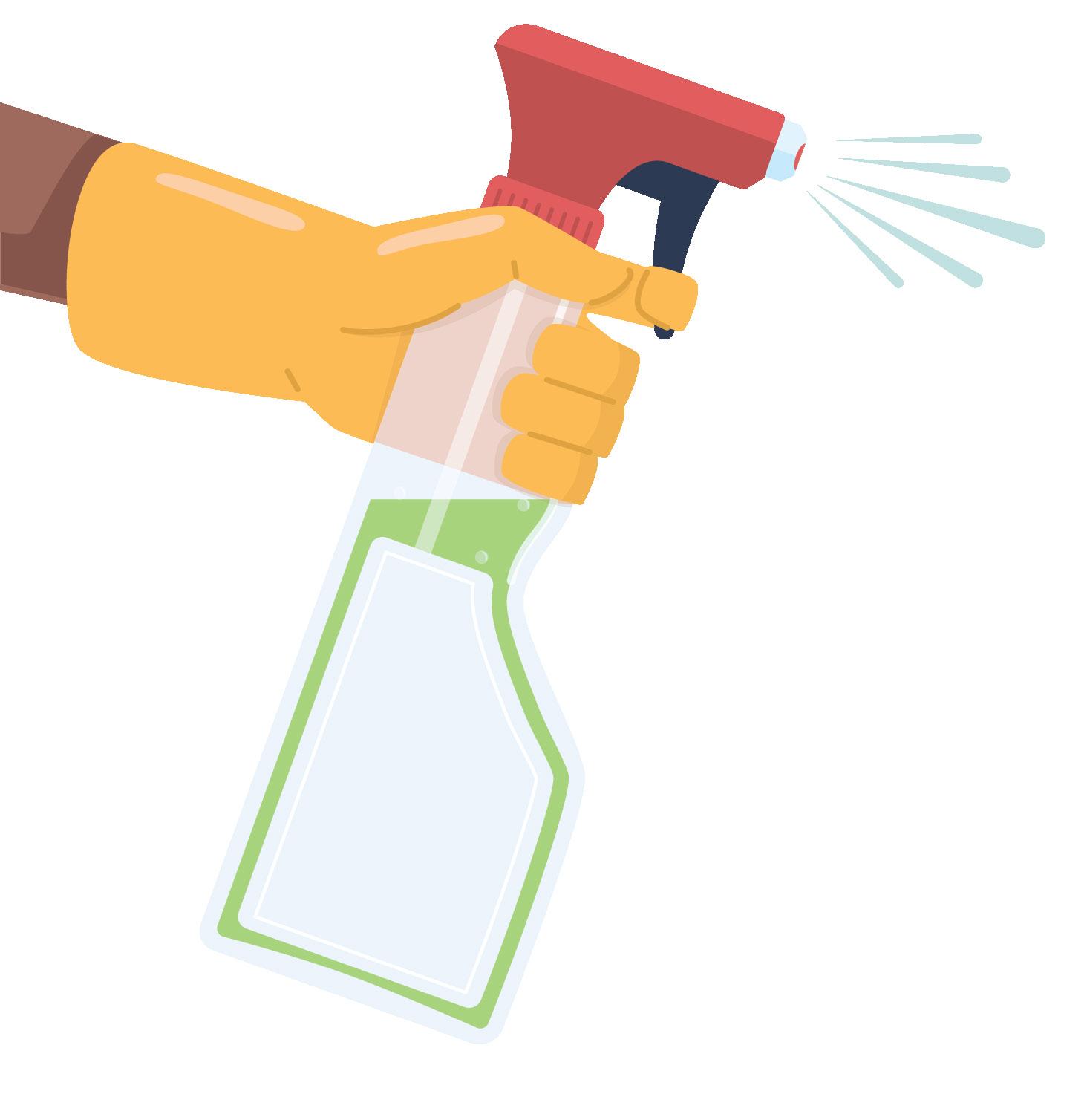
27
DRAFT
TOURISM LINKAGES NETWORK, A DIVISION OF THE TOURISM ENHANCEMENT FUND AGRICULTURAL SUPPLIERS FOOD SAFETY MANUAL
PRODUCE, MEAT AND PRODUCTS
Fresh produce and food products can be contaminated with microbial contaminants such as bacteria and fungi, small traces of chemicals and physical matter such as soil. The sources of these contaminants include food handlers, environment, handling and processing equipment, packing, storage etc.
Best practices for washing produce are:
• Before you begin, wash your hands, counter tops, cutting boards, utensils and equipment with warm soap and water or an approved cleaning solution.
• In some cases, produce is best washed right before sending out for distribution. Washing before storage can sometimes promote bacterial growth. Assess each produce/product accordingly and make the best decision.
• Remove excess/unwanted parts of the produce before washing to limit the amount of dirt, pesticide and microorganism that comes into the washing solution.
• Use potable water to wash produce, products, and packaging;. utilizing municipal water is the safest. If harvest water is being used, ensure the water is appropriately treated and tested.
• Running water is always better to use than still water. If immersing produce in still water, always do so in a clean container and not in a sink; which often harbors microbial growth in the drain area. It must also be noted that still water should be contaminant free.
• Produce with firm skin can be scrubbed with vegetable brush.
• The cleaning and sanitizing methods vary from produce to produce. Conduct research on the most effective way to clean your produce or product and create the relevant SOP.
LINKAGES
ENHANCEMENT
AGRICULTURAL SUPPLIERS FOOD
28 DRAFT
TOURISM
NETWORK, A DIVISION OF THE TOURISM
FUND
SAFETY MANUAL
CONTAINERS AND SUPPLIES
• Containers used for post-harvest processing, storage, processing, and distribution should be compatible with foods and cleaned and sanitized after each use to avoid cross contamination.
• Containers which were contaminated with food from previous supplies can be a significant source of cross contamination and can result in food spoilage, bad odours, and can also come in contact with hazardous substances.
• All containers carrying foods should be inspected before loading of foods and should be free of dirt, debris, chemicals, or biological material.

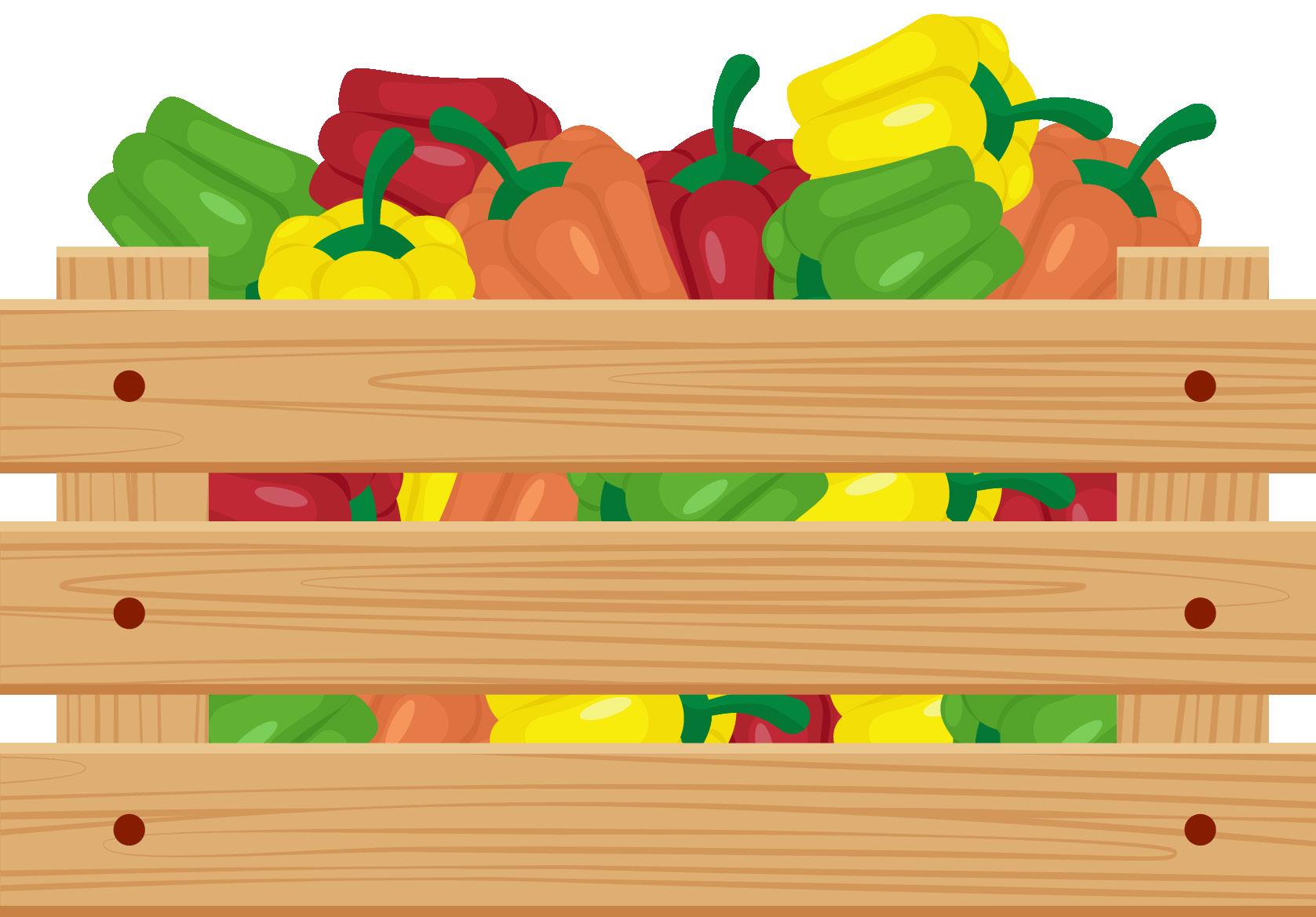
• Vehicles and containers should be dry except for refrigerated units.
• Where appropriate, use closed containers to reduce risk of contamination.
• Do not use containers for fresh food which were previously used for animal products such as meat, milk, and eggs.
• Ensure integrity of the lot by using identification and traceability tags that might exist on containers while cleaning.
• Only use approved cleaning chemicals and ensure containers are thoroughly rinsed.
29 TOURISM LINKAGES NETWORK, A DIVISION OF THE TOURISM ENHANCEMENT FUND AGRICULTURAL SUPPLIERS FOOD SAFETY MANUAL DRAFT
FACILITIES
Cleaning and sanitation programmes should be established for food handling, processing and manufacturing, packing, storage and distribution facilities and equipment.
Facility cleaning programmes MUST include:
• A schedule detailing list of areas to be cleaned
• Personnel responsibility (ies) for the tasks specified
• Cleaning/sanitizing method and frequency
• Use of approved (organizational and local) cleaning products, mixed according to product label
• Monitoring and verification arrangements
• Post-clean inspections
• Pre- start-up inspections
• Parameters for CIP systems including type, concentration, contact time and temperature of any chemicals used
• Specific containers (e.g. Buckets) and cleaning cloths; preferably colour coded, for cleaning surfaces, equipment, kitchen, bathroom, and toilet bowls
AGRICULTURAL
30 DRAFT
TOURISM LINKAGES NETWORK, A DIVISION OF THE TOURISM ENHANCEMENT FUND
SUPPLIERS FOOD SAFETY MANUAL
CHEMICALS
Cleaning agents are an important part of maintaining a clean working environment. However, they can also be a significant chemical food hazard. The recommended best practices are as follows:
• Do not wash produce with detergent or bleach solution. Many types of produce are porous and will easily absorb the chemicals only use approved chemical rinses if water is not sufficient
• Use only approved chemicals which are regulated by the Ministry of Health and Wellness.
• Do not use chemicals that have missing labels and instructions.
• Chemicals should be food grade.
• Store cleaning agents in key and lock and issue to only authorized personnel.
• Use dry or liquid chemicals based on need and applications.
• Maintain logbook for chemicals received and consumed.
• Perform regular chemical residual testing after cleaning and sanitation to ensure complete removal of chemicals
• Employees should be trained in safe handling and use of cleaning agents
• Carefully follow specific manufacturer’s handling and usage instructions for each product
• Employees should wear protective gear, such as goggles and gloves, while handling and working with sanitizers
• Never store cleaning agents in the same area/vicinity as food
clean
31
DRAFT
TOURISM LINKAGES NETWORK, A DIVISION OF THE TOURISM ENHANCEMENT FUND AGRICULTURAL SUPPLIERS FOOD SAFETY MANUAL
4. WORKER HYGIENE
AGRICULTURAL
32
TOURISM LINKAGES NETWORK, A DIVISION OF THE TOURISM ENHANCEMENT FUND
SUPPLIERS FOOD SAFETY MANUAL
DRAFT
Food is handled by food handlers / workers starting from farms, during processing and manufacturing, packing, loading, and unloading. The responsibility for reducing or avoiding contamination while handling food falls heavily on the handlers.
Worker hygiene is essential to the assurance of food safety. Employees can transfer pathogens to food along the entire food chain (farm to fork). This can be avoided through adequate personal hygiene and proper handling of the food, through training and awareness of hygiene, providing basic hygienic facilities and necessary resources.
Employee training in good food-handling practices, covering the key areas of sanitation and worker hygiene, is critical to producing safe food. It is important to ensure that all personnel, including those indirectly involved in processing operations, such as equipment operators, buyers, pest-control operators and visitors, comply with established hygienic practices. Personnel responsible for ensuring the sanitation of the facility should be trained.
33
FUND AGRICULTURAL
FOOD SAFETY MANUAL DRAFT
TOURISM LINKAGES NETWORK, A DIVISION OF THE TOURISM ENHANCEMENT
SUPPLIERS
HAZARDS
Body sprays
First aid materials
MICROBIOLOGICAL
POTENTIAL HAZARDS
Improper worker hygiene can present the following hazards giving rise to food contamination.
HAZARDS
» Cross contamination due to improper handwashing
Contaminated tools
Dirty clothes
Illness from contagious diseases
Bleedings, cuts, flu, cough etc.
Fecal matter and urine
PHYSICAL HAZARDS
» Improper use of PPE (e.g., hair contamination due to partial covering of hair using a hair net or the complete absence of a hair net) » Contamination with personal belongings (e.g., jewellery such as, watches, rings)
»
»
»
»
CHEMICAL
» Perfumes
Cosmetics
Medicines
»
»
»
»
»
AGRICULTURAL
34 DRAFT
TOURISM LINKAGES NETWORK, A DIVISION OF THE TOURISM ENHANCEMENT FUND
SUPPLIERS FOOD SAFETY MANUAL
BEST HYGIENE PRACTICES
• Garments and uniforms must be neat and clean and changed everyday.
• Outer garments must be clean to protect against contamination of produce or packaging materials.
• Always use approved PPE.
• Before each process level of production, wash hands with soap and dry before entering the process area.
• Do not wear jewellery such as wrist watches, rings, bulky earrings, necklaces.








• Regularly clean personal lockers and prohibit food contact materials in personal lockers.
• Wound dressings should not be discarded in processing areas.
• No shorts, sleeveless shirts or vests allowed.
the beginning of work, after returning to the workstation, or at any other time when the gloves become soiled. Damaged gloves should be discarded and replaced.
• Prior to using the restroom, workers should remove PPE such as hair cover/ net, gloves, and apron. After the use of the restroom, standard handwashing and sanitizing procedures must be followed before fitting back protective gear or resuming handling produce/food.
• Store personal effects, such as handbags, cigarettes, and medicines, in separate pre designated areas.



• Food handlers should not wear nail polish, false nails and false eyelashes.




• No eating, chewing, smoking and spitting while handling food.

• Cover head and beard properly.




• Hair and nails should be properly maintained and short.



• Persons with long beards must wear a beard cover.

• Footwear must be appropriate and in good repair; no open-toed shoes are allowed.


• A plastic apron is recommended when handling water or dirt.
• Workers should not wear their coveralls or aprons in areas other than the packing, processing, manufacturing, operation areas or as intended.




• No food, candy, chewing gum or cough drop should be allowed in the operation areas.

• If employees wear gloves they must be of a resistant material. Gloves must be cleaned and/or sanitized at
• Smoking is not permitted in the facility and ‘no smoking’ signs must be posted at strategic locations in the packing facility. This is also applicable on the farm as smoking influences the incidence of the tobacco mosaic virus in peppers. Spitting, chewing, eating, sneezing, or coughing in proximity to food is unacceptable because it increases the risk of contamination. An area outside of the packing facility may be designated for smoking.
• Food Handlers Permits must be acquired for all tourism food suppliers2.
2 To learn more about qualifying and applying for a Food Handlers Permit, visit: https://nerha.gov.jm/apply-food-handlers
TOURISM LINKAGES NETWORK, A DIVISION OF THE TOURISM ENHANCEMENT FUND AGRICULTURAL SUPPLIERS FOOD SAFETY MANUAL
X
X X
X
X
X
35
DRAFT
HYGIENE FACILITIES
Hygiene facilities must be available at farms, processing, and manufacturing, packing, storage and distribution sites. Hygiene facilities should be accessible to workers to ensure that an appropriate degree of personal hygiene can be maintained. The facilities shall be located close to the points where hygiene requirements apply and shall be clearly designated. Hygiene facilities are the cornerstone of an effective food safety management system. It covers different activities as explained below.
Hygiene facilities at farms include:
A) HAND WASHING
Hand Washing is the first and most important factor in achieving and maintaining personal hygiene. It includes below key activities as
• Adequate numbers of hand washing facilities should be available for workers.
• Hand washing facilities should be in close proximity to the work area to make them readily accessible.
• Hand washing facilities must contain soap/hand washing liquid.
• Hand dryers or other drying material like paper towels should be provided at hand wash stations.
• Disinfectant/sanitizers should also be provided at hand washing facilities keeping in view COVID-19 protocols.
• Hand wash instructions should be placed at all handwashing facilities to ensure effectiveness.
• If possible, install sensors for the taps of handwashing stations to avoid cross contamination.
• Food handling areas and hand wash stations should be separate from those used for equipment cleanings.
• Records of cleaning and of hand washing stations should be maintained.
01 02 03 Wet hands with water Apply soap Rub hands palm to palm 04 05 06 Fingers interlaced and back of hands Clean thumbs Clean fingernails 07 08 09 Rub wrists Rinse hands with water Dry hands with a clean towel STEPS ON PROPER HANDWASHING TOURISM LINKAGES NETWORK,
OF THE TOURISM ENHANCEMENT FUND AGRICULTURAL SUPPLIERS FOOD SAFETY MANUAL 36 DRAFT
A DIVISION
B) TOILETS
• Provide an adequate number of permanent or mobile toilets of appropriate hygienic design, each with hand-washing, drying and, where required, sanitizing facilities.
• Toilets should not open into food packing, storage or handling areas.
• Cleaning of toilets should be done regularly and cleaning records maintained.
C) CHANGING AREAS
• Farms, food handling, processing and manufacturing facilities must have an adequate number of appropriate changing facilities for workers
• Workers must change their work wear before entering into production and food handling areas to avoid contamination.
• Change rooms should not open into food handling or storage areas.
• Direction and signage must be placed there regarding use of change rooms.
D) PERSONAL STORAGE AREAS

• Farms, food handling, processing and manufacturing facilities must provide an adequate number of lockers or designated storage areas.
• Cleaning and maintenance of lockers should be done frequently to protect waste accumulation.
• No food items and contact materials should be kept in personal lockers.
• Locker use instructions should be provided.
• Records of cleaning and maintenance of lockers should be maintained.
TOURISM LINKAGES NETWORK, A DIVISION OF THE TOURISM ENHANCEMENT FUND AGRICULTURAL SUPPLIERS FOOD SAFETY MANUAL
37
DRAFT
E) CANTEENS OR DESIGNATED EATING AREAS
• Canteens or designated eating areas should be available at farms, food handling, processing and manufacturing facilities to minimize impact of contamination to food handling areas.
• Food items or ingredients should be stored hygienically.
• Food cooking, storage and serving should be done hygienically to avoid spread of contaminants.
• Cooking and holding temperatures/time should be monitored and specified.
• All personnel involved in food cooking, preparations, serving should be medically examined on a yearly basis and must have a current food handler’s permit.
• Employees’ food should be stored in identified areas. Employees should not be allowed to eat in food handling, packing and storage areas.
• Daily cleaning of eating areas should be done and records are maintained.
• Food waste should be collected in waste bags and disposed of properly.
F) WORKWEAR AND PERSONAL PROTECTIVE EQUIPMENT
• Workers at farms who work in, or enter areas containing food products, fruits, vegetables and/or materials must wear proper work clothing that is fit for purpose.
• It should be clean and in good condition (e.g., free from rips, tears, or fraying material).
• PPE worn in food handling areas should not be worn in other areas.
• Hair and long beards must be covered or restrained.
• Where gloves are used for product contact, they shall be clean and in good condition. Latex gloves should be avoided where possible, as latex is a common allergen.
• Shoes worn in processing areas shall be fully enclosed and made from non-absorbent materials.
• PPE, where required, must be designed to prevent product contamination and be maintained in a hygienic condition.
TOURISM LINKAGES NETWORK, A DIVISION OF THE TOURISM ENHANCEMENT FUND AGRICULTURAL SUPPLIERS FOOD SAFETY MANUAL 38 DRAFT
DEALING WITH SICK WORKERS
To reduce the risk of biological contamination, sick workers should not be allowed to handle food. Sick people could be a source of food safety hazards and can deteriorate a hygienic environment. Sick workers should be properly treated and reported to avoid food contamination or transmission to other workers, if the illness is contagious. Below is a list of preventive controls and guidelines that should be adopted:
• To ensure food safety, illnesses and injuries should be reported to the farmer in charge / or site supervisor.
• Ill or injured persons should immediately be transferred out from food handling areas to other areas or sent on leave.
• Visible symptoms such as jaundice, diarrhea, vomiting, fever, sore throat with fever, skin lesions (boils, cuts, or sores) and discharges from the ear, eye or nose are signs of illness. Workers showing any of these symptoms should not have access to food .
• In food-handling areas, personnel with wounds or burns shall be required to cover them with specified colored detectible dressings. Any lost dressing shall be reported to supervision immediately.
39
DRAFT
TOURISM LINKAGES NETWORK, A DIVISION OF THE TOURISM ENHANCEMENT FUND AGRICULTURAL SUPPLIERS FOOD SAFETY MANUAL
5. WATER
40
TOURISM LINKAGES NETWORK, A DIVISION OF THE TOURISM ENHANCEMENT FUND
AGRICULTURAL SUPPLIERS FOOD SAFETY MANUAL
DRAFT
Water is a critical resource for food production, processing and manufacturing operations. However, water is also a significant source of potential food hazards. Management of the resource is therefore critical to ensure effective food management systems are in place.
POTENTIAL HAZARDS
Based on the source, water becomes a great potential source of contaminants i.e., chemical, physical, and microbiological hazards as:
MICROBIOLOGICAL HAZARDS
CHEMICAL HAZARDS
» High Total Dissolved Salts » Salts of Calcium and Magnesium » High Iron content » High Arsenic Contents
» Residual disinfectants » High Sulphates » High concentration of sodium, potassium other metals
PHYSICAL HAZARDS
» Suspended solids » Dirt and debris » Litter
» Plant parts such as leaves and stems » Animal waste
» Virus » Fungus » Various life cycles of pests » Plant and animal parts DRAFT
TOURISM LINKAGES NETWORK, A DIVISION OF
TOURISM
41
THE
» Contamination with microorganisms » Fecal Coliforms » Bacteria such as Pseudomonas and Escherichia ENHANCEMENT FUND AGRICULTURAL SUPPLIERS FOOD SAFETY MANUAL
•
WATER QUALITY AND SOURCES
Water Quality is important for the food supply chain. Water contaminated with any of the potential food safety hazards would become a major source of contamination of food. Generally, Jamaica’s water quality ranks among the best in the world. This is usually because of a combination of two factors; high quality surface and aquifer water sources rigorous municipal water treatment infrastructure. In general, farmers and manufacturers can source water from several points, depending on zoning regulations and access. These include:
• Municipal System
• Underground Wells/Aquifers
• Rivers
•
Rainwater Reservoirs
Onsite Storage Tanks
For all water sources, except for that from the National Water Systems, tourism food suppliers MUST implement suitable treatment, remediation and testing capabilities to ensure water is safe for use. Site managers are responsible for conducting water system risk assessment determining the best water treatment systems for their facilities. Recommended approaches include:
• Filtration
• Softeners
• Distillation
• Disinfection (UV, heat, chlorine)
Onsite
Municipal System Underground Wells/Aquifers
Rivers Rainwater Reservoirs
AGRICULTURAL
42 DRAFT
Storage Tanks TOURISM LINKAGES NETWORK, A DIVISION OF THE TOURISM ENHANCEMENT FUND
SUPPLIERS FOOD SAFETY MANUAL
WATER SUPPLY
The supply of potable water must be sufficient to meet the needs of food handling, washing, processing and manufacturing facilities.
• Water in contact with products or product surfaces, shall meet specified microbiological requirements relevant to the product.
• Water for cleaning or applications where there is a risk of indirect product contact (e.g., equipment) shall meet specified microbiological requirements relevant to the application.
• Where water supplies are chlorinated (disinfected) in-house, checks shall ensure that the residual chlorine level at the point of use remains within limits given in relevant specifications.
• Non-potable water shall have a separate supply system that is labelled and not connected to the potable water system.
• Take measures to prevent non-potable water refluxing into the potable system.
• It is recommended that water that can come into contact with the food should flow through pipes that can be disinfected.
• Keep records on frequency of testing and results.
WATER TEST
Water tests should be performed to monitor water quality for water sources other than the municipal system. Water tests can be performed in-house or from any accredited 3rd party lab.3 Water quality must align to the standards set by the National Environment and Planning Agency (NEPA) . Some of the important quality tests of water are:
PHYSICAL TESTS
i. Odor and Appearance ii. Color iii. Turbidity iv. TDS total dissolved solids v. TSS total suspended solids vi. pH (Measure of Acidity / Basicity)
CHEMICAL TESTS
i. Water Hardness (Calcium / Magnesium) ii. Chlorides iii. Sulphates iv. Sodium v. Potassium vi. Iron vii. Nitrites viii. Fluoride ix. Alkalinity
MICROBIOLOGICAL TESTS
i. Total Plate Count ii. Total Fecal Coliform iii. E-Coli iv. Pseudomonas
3 Examples include Scientific Research Council, Bureau of Standards Jamaica, Ministry of Health, Environmental Solutions, Technological Solutions
TOURISM LINKAGES NETWORK, A DIVISION OF THE TOURISM ENHANCEMENT FUND AGRICULTURAL SUPPLIERS FOOD SAFETY
43
DRAFT
MANUAL
6. HARVESTING AND HANDLING
LINKAGES NETWORK, A DIVISION OF THE TOURISM ENHANCEMENT FUND AGRICULTURAL SUPPLIERS FOOD SAFETY MANUAL 44 DRAFT
TOURISM
Harvesting and handling can be done manually or using machinery. Harvesting and handling of crops and animal produce need extreme care atbecause all stages because harvesting processes can be a critical point of food contamination. Wrong and improper harvesting and handling procedures could result in financial loss to grower and contamination of crop produced with chemical, microbiological, and physical food safety hazards.
POTENTIAL HAZARDS
PHYSICAL HAZARDS
• Birds and animals dropping on food before and during harvesting
• Environmental dust and debris
• Solid wastes depositions
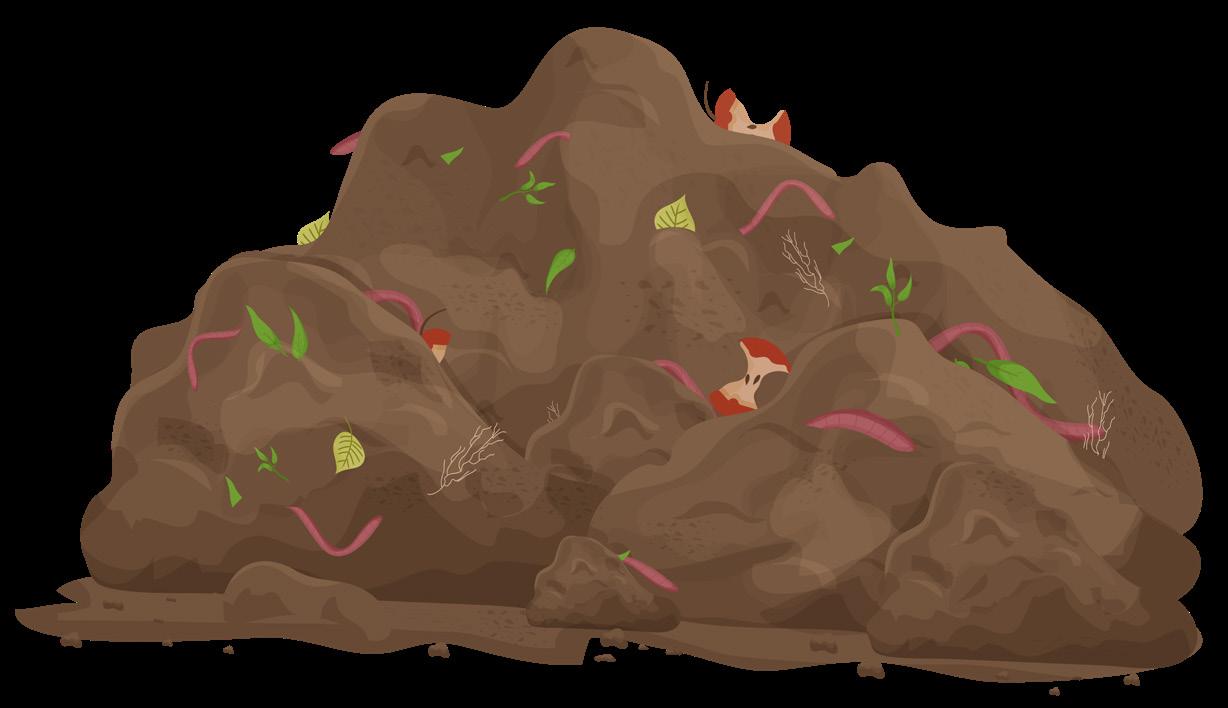
• Soil particles during harvesting and handling
• Particles from handling equipment
• Foreign particles from food handlers such as hair, jewelry, buttons, personal belongings.
• Loose and damaged parts from machinery used in harvesting
• Other foods items mixing
• Pests and insect parts
• Remains of crops and food plants
• Packing and transporting – compression, bruising
CHEMICAL HAZARDS
• Cleaning and sanitation residual chemicals from harvesting tools and equipment
• Residual insecticides, herbicides, and fertilizers
• Surface of equipment, machinery and containers used in harvesting made of toxic elements
• Containers used for holding produce are used in other hazardous applications.
• Harvested crops/produce stored in areas where chemicals, fertilizers or pesticides were previously stored.
• Contaminated vehicles used for transporting produce
45
DRAFT
TOURISM LINKAGES NETWORK, A DIVISION OF THE TOURISM ENHANCEMENT FUND AGRICULTURAL SUPPLIERS FOOD SAFETY MANUAL
BIOLOGICAL HAZARDS
• Contamination from workers during manual handling
• Spoiled foods cross contaminating fresh foods
• Waste particles from animal remains
• Dead insects/pests
• Tools, equipment, equipment and food contact materials that have not been properly cleaned/sterilized
• Storage of harvested food on floor or contaminated areas
• Open storage and handling of harvested foods
• Storage of food at wrong temperatures
• Washing and cleaning of harvested food with contaminated water
• Contaminated vehicles used for transportation
FOOD CONTACT MATERIALS/TOOLS
Tools, equipment, and materials (food contact materials) should be managed to reduce the risk of contamination during harvesting, handling, and processing. The best approaches are as follows.
• Use appropriate tools and materials suitable for food harvesting and handling
• Use only food grade materials and tools
• Tools used in food harvesting and handling should not be used for other non-food applications.
• Regular inspection and maintenance of tools and materials to avoid damages and deteriorations.
• Tools used in food applications should not be made of toxic elements.
• Regular and scheduled cleaning and sanitation must be conducted.
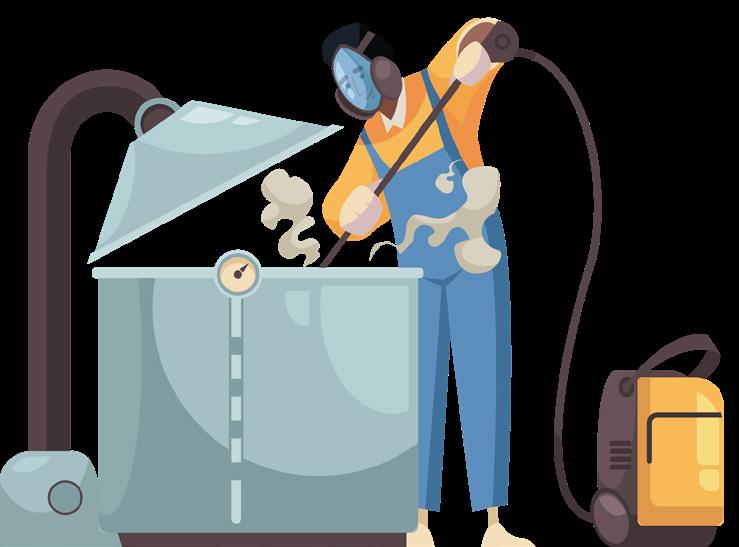
• Clean and sanitize tools, materials, and equipment after each use or according to prescribed maintenance protocols.
• Do not put tools and equipment in direct contact on soil
• Spoiled or rotting food should not be stored in close proximity to food contact materials.
TOURISM LINKAGES NETWORK, A DIVISION OF THE
ENHANCEMENT FUND AGRICULTURAL SUPPLIERS FOOD SAFETY MANUAL 46 DRAFT
TOURISM
PERSONNEL
• Promote worker hygiene best practices
• Strictly follow hand washing practices

• Sick and injured workers should not be allowed in direct contact with foods or food contact materials.
• Follow illness and injuries reporting.
• Training and awareness of personnel on food safety.
• Medical fitness of personnel protocols must be maintained.
• Personnel involved in food handling are not used for nonfood handling.
EQUIPMENT
• Equipment used in food handling should be safe to use
• Made of durable materials
• Made of food grade materials
• Cleaning and sanitation of equipment is done regularly
• Ensure equipment is regularly maintained and calibrated where necessary
• Equipment should be systematically cleaned according to manual instructions
• Equipment is to be stored in clean areas only
• Equipment used for harvesting of food should not be used in other non-food applications.
47
DRAFT
TOURISM LINKAGES NETWORK, A DIVISION OF THE TOURISM ENHANCEMENT FUND AGRICULTURAL SUPPLIERS FOOD SAFETY MANUAL
MAINTAINING FOOD QUALITY
• Develop and implement food quality plans aligned to tourism establishment purchasing requirements
• Perform inspection, testing and analysis of harvested foods
• Maintain quality records of all outputs aligned to deliveries
• Harvested and packed food, crop produce should be stored in dedicated area free from all contaminants
• Harvested food handling areas should be free from water leakages, seepage, rainwater to avoid growth and contamination from microorganisms.
• Smoking and eating is not allowed during harvesting and handling of food
• Workers with illness and injuries should not be allowed to harvest and handle food
• To ensure food quality of harvested and packed items, temperature and humidity is monitored and records maintained.
• Use food grade packaging/materials
• Perform grading and segregation of foods based on postharvest indicators and parameters
• Only release or supply food which is safe for consumers
• Ensure foods are aligned to national Produce Grading Manual and the national food quality standards from the Bureau of Standards Jamaica (Appendix 2)
• Maintain records of all food quality related information.
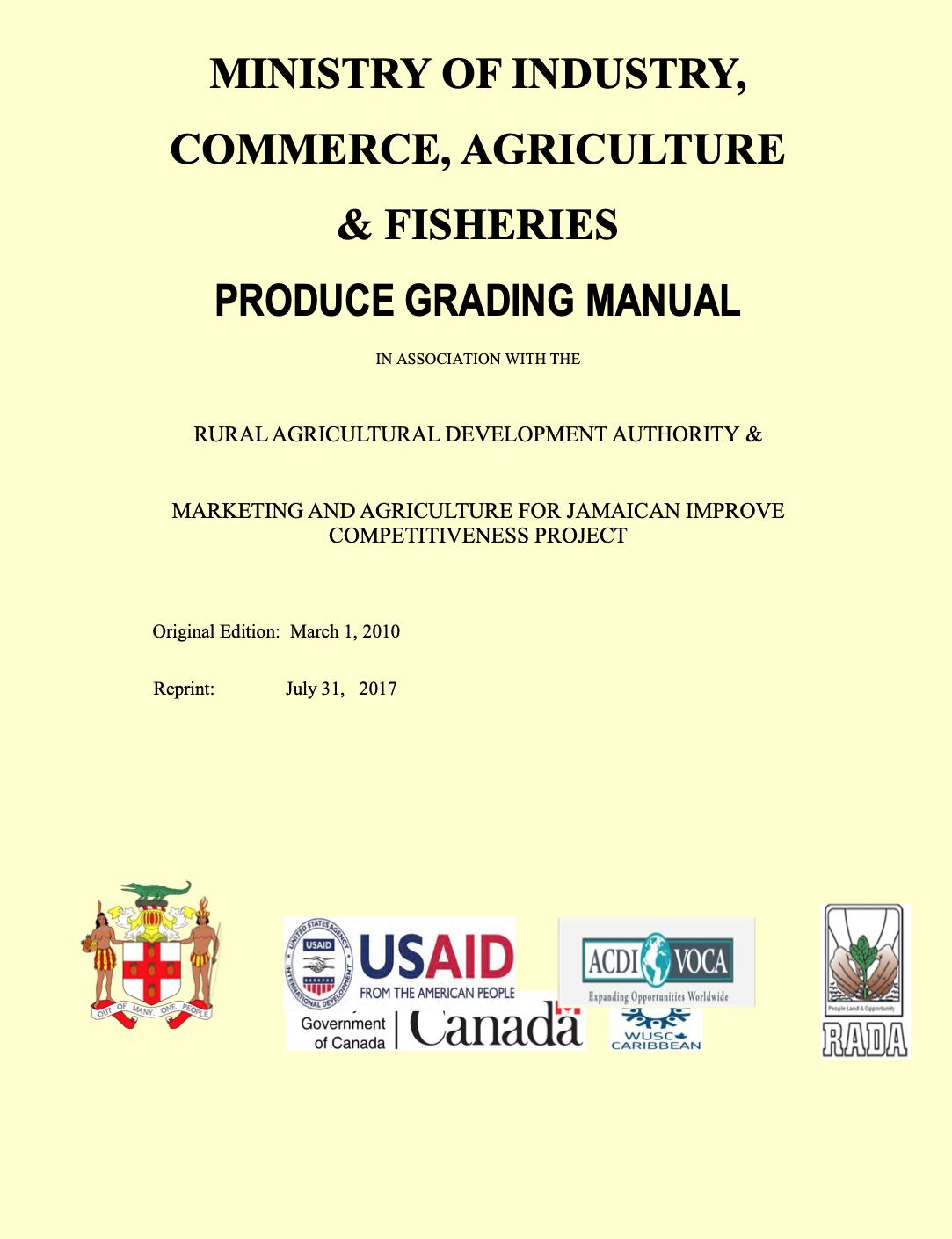
TOURISM LINKAGES
AGRICULTURAL
MANUAL 48 DRAFT
NETWORK, A DIVISION OF THE TOURISM ENHANCEMENT FUND
SUPPLIERS FOOD SAFETY
3. STORAGE AND TRANSPORTATION
49
DRAFT
TOURISM LINKAGES NETWORK, A DIVISION OF THE TOURISM ENHANCEMENT FUND AGRICULTURAL SUPPLIERS FOOD SAFETY MANUAL
Improper storage and dispatch of food lends to significant contamination of food, even if food is free of contamination at the preceding process steps.
POTENTIAL HAZARDS
PHYSICAL HAZARDS
» Soil, dirt, debris and litter from storage areas and transportation vehicles
» Pests, insects, droppings
» Pieces of broken /damaged pallets
» Food and packaging remains from previously stored stock or dispatch
» Non-food items in storage areas and transport
» Handlers, such as drivers and delivery support personal effects such as jewelry, hair, gloves etc.
CHEMICAL HAZARDS
» Chemicals stored and transported near food (such as pesticides, fertilizers, oils)
» Residual disinfectants used in storage areas and transport vehicles
» Aerial particulate matter from chemical storage in close proximity to food.
» Fuel exhaust (particulate) from vehicles.
» Non-compatible transport vehicles
» Transport of food in vehicles having chemicals items
BIOLOGICAL HAZARDS
» Storage of food items on soil or ground
» Storage of packed food items in open place, direct sunlight
» Storage at wrong environmental temperature and humidity
» Transport vehicles without temperature control functions
» Unsanitary transport vehicles
» Transport of food in vehicles which also transports waste material
» Food handlers in transportation vehicles and storage areas
TOURISM
ENHANCEMENT FUND AGRICULTURAL SUPPLIERS
MANUAL 50 DRAFT
LINKAGES NETWORK, A DIVISION OF THE TOURISM
FOOD SAFETY
CONTAINERS
Containers used to store and transport food should be handled in an appropriate way to avoid contamination from physical, chemical, and microbiological hazards. Good practices for food containers should be implemented as follows:
• Food containers with food are not placed directly on soil to avoid potential contamination from soil particles.
• Containers used for food packing, storage and transport should be made of food grade materials.
• Containers should be dedicated for storage for foods and not other materials.
• Container surfaces should not be made of hazardous or toxic materials.
• Containers when packed with food should be stored separately away from non-food items.
• Containers having food items should be transported in vehicles dedicated for food items.
• Food containers, even when not in use, are not stored with chemicals.
• All containers having food items should be provided with traceable food labelling and identification.
• Containers should be stackable and can withstand compression.
51
DRAFT
TOURISM LINKAGES NETWORK, A DIVISION OF THE TOURISM ENHANCEMENT FUND AGRICULTURAL SUPPLIERS FOOD SAFETY MANUAL
STORAGE OF PRODUCE - AMBIENT CONDITIONS
Storage of fresh produce at specified temperatures is a common practice used by farmers and processors. Fresh food products are characterized by their perishability, and levels of vulnerability to pests and spoilage. However, the control of temperature and relative humidity can also significantly increase the shelf-life and quality of foods.
Biological deterioration, caused by respiration rate, ethylene production, mechanical injuries, water stress, physiological disorders and pathological breakdown can lead to decay, loss in nutritive value, and changes in color, texture, and flavor. Factors influencing the rate of deterioration are temperature, the level of relative humidity, air velocity, atmospheric composition, sanitation, and storage duration. It is imperative of food supply managers to conduct research and establish critical limits and standards for the ambient storage conditions (temperature and humidity at a minimum) for their produce and products.4
Where necessary/appropriate, fresh produce must be supplied to tourism establishments on the same day or very next day to maintain food safety and quality.

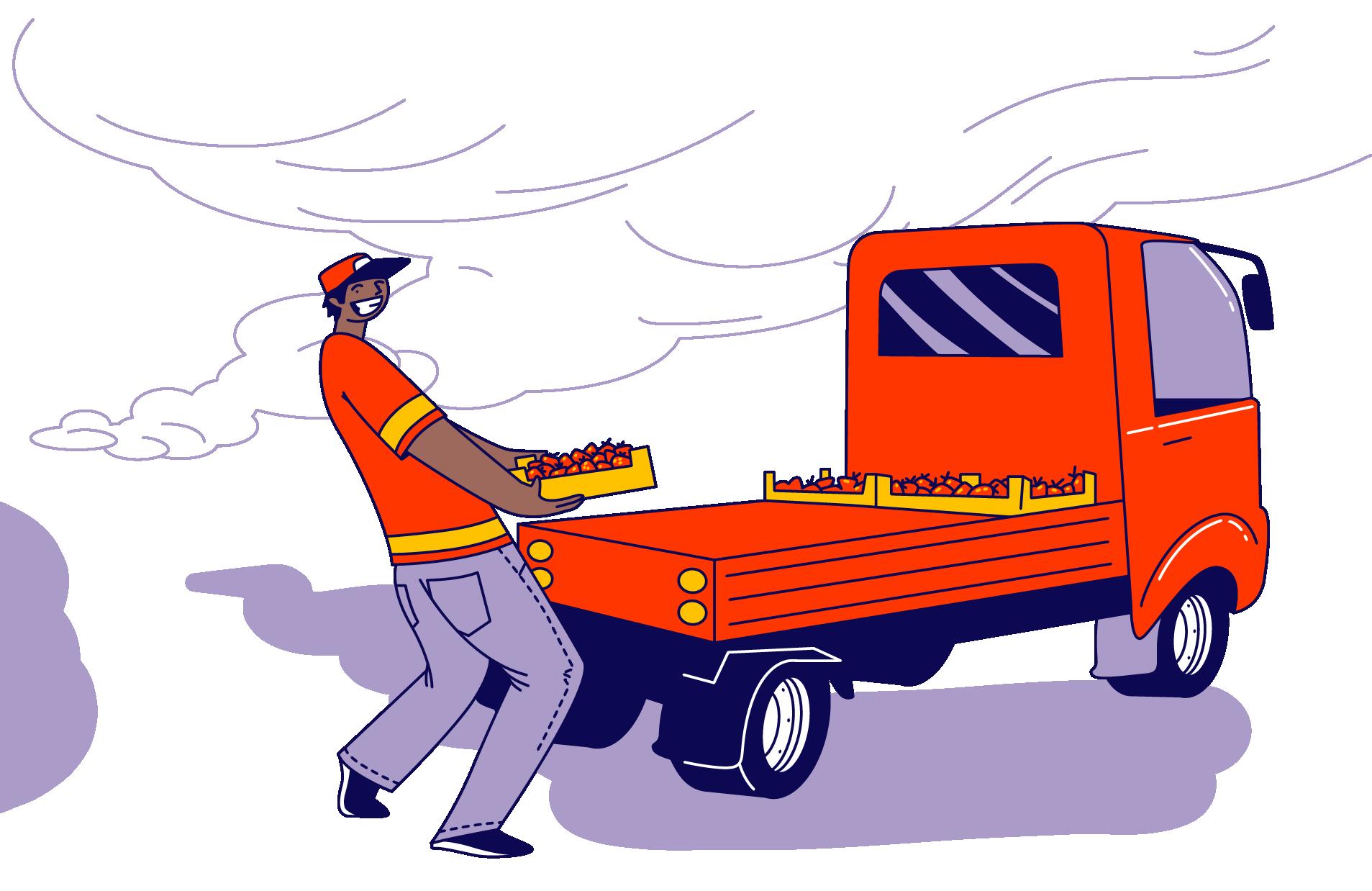
Food supplying the tourism industry must be stored in temperature controlled and/or monitored facilities. Cool and cold storage facilities are very important to reduce post-harvest losses and maintain food safety. Some of the key implementations of storage facilities are as follows:
• Thermometers must be installed in storage facilities. These can be electronic or manual readers.
• A relative humidity meter is strongly recommended to ensure optimal storage conditions are maintained.
• Records of regular readings must be maintained.
• Critical limits must be established for temperature and humidity, with control measures in place in the event of variation.
• Where air conditioning is absent, other mechanisms to maintain required temperature must be installed, such as fans, large windows, or shading structures
• Where there is multicrop storage, implement systems to minimize quality change in other produce, such as ripening due to ethylene production.
4 https://www.fao.org/3/y4893e/y4893e06.html TOURISM LINKAGES NETWORK, A DIVISION OF THE TOURISM ENHANCEMENT FUND AGRICULTURAL SUPPLIERS FOOD SAFETY MANUAL 52 DRAFT
STORAGE OF PRODUCE – FACILITIES
Cleaning, sanitation, and maintenance of storage facilities are also very important to food safety systems in food production operations.
• All storage facilities should be properly monitored for pests with the requisite pest control treatment methods and records.
• Storage facilities must have a proper drainage system to avoid water accumulations.
• Materials should be stored off the floor/ground on pallets, slip-sheets or stands and covered where applicable.
• Storage areas must be maintained so as not to be a source of product contamination.
• Areas designated to store materials, whether indoors or out, must be clean, well ventilated, and designed to protect materials and produce from contaminants
• In processing or manufacturing facilities, incoming raw materials must be stored separately from outgoing finished goods.
• All producers of meat supplying the tourism industry must be registered and approved by the Veterinary Services Division of the Ministry of Agriculture and Fisheries. To apply, visit https://www.moa.gov.jm/sites/default/files/Slaughtering%20 Application%20Form.pdf
• All importers and purveyors of food supplying the tourism industry must have facilities approved by the Plant Quarantine Division to ensure safe phytosanitary conditions and processing.
The Food Storage and Prevention of Infestation Division5 provide a series of services, training programmes and informational resources to equip tourism agricultural suppliers to effectively manage storage facilities.
5 https://www.fspid.gov.jm/index.html
53
DRAFT
TOURISM LINKAGES NETWORK, A DIVISION OF THE TOURISM ENHANCEMENT FUND AGRICULTURAL SUPPLIERS FOOD SAFETY MANUAL
TRANSPORTATION VEHICLES
Transportation vehicles are another potential source of food hazards. The following are the key measures that should be taken to prevent food contamination as a result of transportation:
• Vehicles should be checked before use for cleanliness, foreign objects, and vermin infestation, and cleaned if there is a significant risk of contaminating produce and products.
• Do not use vehicles which were previously used for nonfood items transportation such as animals, chemicals, manure, waste handling etc. If the same vehicle is to be used, ensure they are properly cleaned and sanitized after each use.
• Vehicle should not pose any toxic or hazardous risk to food i.e., made of materials which are toxic and incompatible to foods.
• Vehicles must have a temperature control function for perishable foods. Temperature should be monitored during transit using data loggers or some other suitable means.
• Closed vehicles are strongly encouraged for food transport to avoid environmental contamination such as dust, foreign particles, rains etc.
TOURISM LINKAGES NETWORK, A DIVISION OF THE TOURISM ENHANCEMENT FUND AGRICULTURAL SUPPLIERS FOOD SAFETY MANUAL 54 DRAFT
PACKAGING/ HANDLING DURING TRANSPORTATION
Food products deteriorate with time as a result of microbial activity. Microorganisms, such as fungi and bacteria, often penetrate food resulting in spoilage and toxin accumulation. This renders food unsafe for human consumption.
Food storage methods especially during transportation have a great impact on its safety and quality. This is because transportation conditions favor the different deterioration and infestation processes. Therefore, in order to maintain proper quality, food handlers need to limit access to the products by harmful microorganisms and prevent population growth and colonization. Some of the key aspects are defined below.
• Improper refrigeration or temperature control of food products including intentional abuse or violation of practices by drivers such as turning off refrigeration units during waiting time for unloading of vehicles should be prohibited.
• Transportation units and relevant storage facilities should have structured management systems.
• Standards for packing of produce and products during transportation must
be established.
• Improper loading practices, conditions, or equipment, including improper sanitation of loading equipment, leaving produce on loading areas for prolonged periods increase the risk for cross-contamination and should therefore be prohibited.
• Where necessary security for transportation units or storage facilities must be in place, such as security seals, security checks and distribution records.
• Pest control management systems must include transportation units.
• Provide training and capacity building for drivers and loaders on food safety and quality.
• All transportation units must be enrolled in preventive maintenance programmes to avoid deterioration in the physical structures resulting in roof leaks, gaps in doors, and dripping condensation or ice accumulations.
• Transportation personnel must adhere to worker hygiene protocols.
• Adequate policies for the safe and/or secure transport or storage of foods must be in place.
• Systems for tracking rejected loads, salvaged, reworked, and returned products or products destined for disposal should be established.
• Establish holding practices for food products awaiting shipment or inspection, including unattended product, delayed holding of product, shipping of product while in quarantine, and poor rotation and throughput.
• Ensure traceability systems include food products during transportation and storage.
TOURISM LINKAGES NETWORK, A DIVISION OF THE TOURISM ENHANCEMENT FUND AGRICULTURAL SUPPLIERS FOOD SAFETY MANUAL
55
DRAFT
8. TRACEABILITY
AGRICULTURAL
56
TOURISM LINKAGES NETWORK, A DIVISION OF THE TOURISM ENHANCEMENT FUND
SUPPLIERS FOOD SAFETY MANUAL
DRAFT
Traceability is the ability to track a food products through each stage of the supply chain, both forward and backward. Traceability systems rely on accurate documentation that links the production of food (farmers) to the consumption of food (tourist). Traceability is critical in a sustainable food supply chain as it allows efficient tracing and sourcing of contaminated food should a foodborne illness outbreak or prevalent break in food quality occur. Traceability systems throughout the supply chain significantly reduces the risk to public health and financial losses to food suppliers.
Where unsafe produce and products are identified, a formal recall (voluntary or mandatory), should be issued. After a recall, unsafe food must be appropriately disposed of. Recalled products if not properly managed would result in contamination of food and facilities.

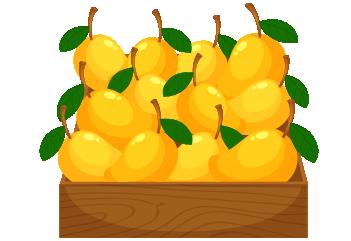
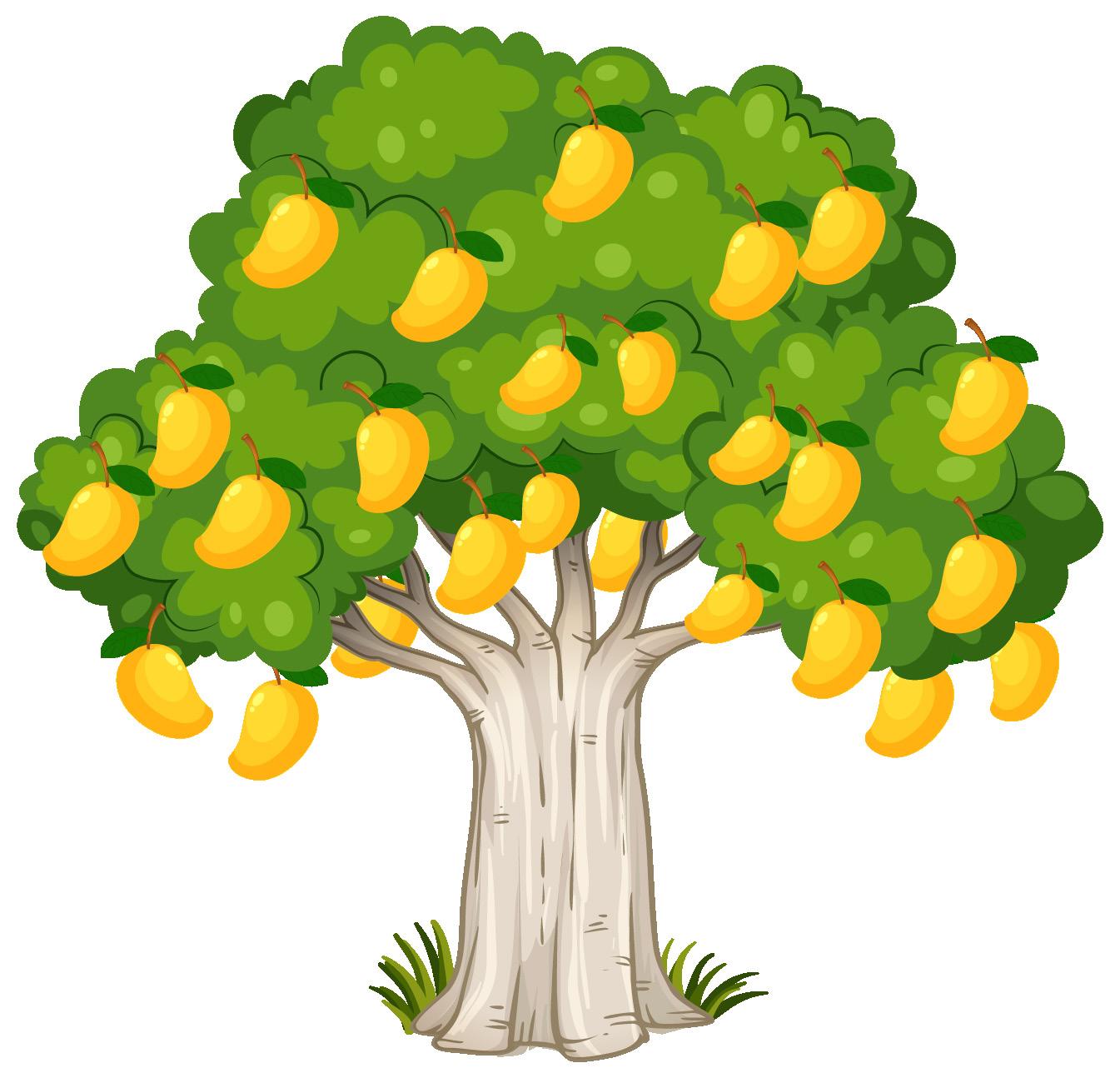




In a food supply chain, multiple parties are involved. An effective traceability system requires involvement of all parties to link the physical flow of products with the flow of information. Adopting uniform industry requirements for traceability processes ensures agreement about identification of the traceable items between parties. This supports transparency and continuity of information across the supply chain.
To date, there are no established industry-wide (tourism and agriculture) standards for food traceability in Jamaica. In lieu, consult with the purchasing and food preparation departments of the tourism establishment (buyer) or purveyors. Develop agreed upon standard operating procedures to support traceability of foods from the production facility to the end consumer. The subsections below provide best practices that can be applied to the food supply chain established between your supply and the consumers.
57
DRAFT
TOURISM LINKAGES NETWORK, A DIVISION OF THE TOURISM ENHANCEMENT FUND AGRICULTURAL SUPPLIERS FOOD SAFETY MANUAL
TRACEABILITY BEST PRACTICES
INTERNAL TRACEABILITY
All produce, products and inputs should be traceable through an internal traceability system. In the case of animals raised for food, the National Animal Identification and Traceability System (NAITS) should be implemented.
EXTERNAL TRACEABILITY
To maintain external traceability, information is communicated to distribution channel participants on product labels and related paper or electronic business documents. All players within the supply chain (transportation, purveyors, collectives, tourism establishments’ warehouse and kitchen) should record or utilize the unique code to link the physical products with the information requirements necessary for traceability.
REAL TIME PRODUCTION DATA
Real time production data is critical in the event of a recall. It supports routine inspections and audits, supports ongoing surveillance, and supports the decision- making process using reliable evidence from all players in the supply chain. Regulatory agencies such as those from the Ministry of Health, Industry and Agriculture may also request copies of traceability records.
A unique traceability code should be applied to each produce supply or product and should remain on the packaging until that entire traceable item is depleted. The products are identified for the purpose of traceability using this unique product identification code. This principle applies even when the traceable item is part of a larger packaging hierarchy (such as cases, pallets, or shipment containers). Internal traceability helps during an event of product recall to determine specific harvest, raw materials, chemical inputs, sourcing of materials, harvesting/processing date, personnel involved and when and to whom it was sold.
QUALITY IMPROVEMENTS
Traceability information should be linked to quality reports of produce and products. By linking problem products to specific produce and products, it is possible to connect the deficiencies in the operation which lead to issues along the value chain. This analysis can be used to support ongoing efforts to improve standard operating procedures and quality and safety outcomes.
58 DRAFT
TOURISM LINKAGES NETWORK, A DIVISION OF THE TOURISM ENHANCEMENT FUND
AGRICULTURAL
SUPPLIERS FOOD SAFETY MANUAL
9. WASTE MANAGEMENT
59
SUPPLIERS FOOD
MANUAL DRAFT
TOURISM LINKAGES NETWORK, A DIVISION OF THE TOURISM ENHANCEMENT FUND AGRICULTURAL
SAFETY
Throughout the food supply chain, different types of waste (liquid, solid, biological, hazardous, nonhazardous) are generated. Proper waste management systems are required for all suppliers of produce and products.
GENERAL FOOD PRODUCTION WASTE
Farms produce a variety of wastes during and after food harvesting. When organic farm waste such as remains of crops, animal waste, foods, plastic, paper, and wood accumulate, it results in a higher potential for biological and physical contamination. Poor waste management often results in poor food safety via the following means:

• Waste from harvesting, food processing and production
• Utilized food in storage and handling areas
• Damaged food (write-offs)
• Unsold food (deadstock)
• Wastewater
• Waste containers
• Container and food spills
• Dirty waste receptacles
• Spoiled food
• Damaged packing materials
• Foreign particles from food handling containers
To reduce the risk of waste material to food safety, manage these waste streams in the following ways:
• Remove food waste and other waste materials from the areas where the food is being handled, cooked or manufactured.
• Provide an adequate amount of refuse receptacles, of appropriate sizes, with covers on the premises for collection of waste.
• Internal receptacle waste should be consolidated daily at an assigned collection point where they can be emptied into a municipal garbage collection system.
• Wash smaller receptacles in production facilities daily with disinfectants and dried before next use.
• Separate liquid, solid and hazardous waste at the time of placing them in the bins.
• Position waste receptacles in such a manner that it does not lead to contamination of the food process, food storage area and environment inside and outside your premises.
• Dispose food waste in such a way that it does not attract dogs, cats, birds, rodents, and flies.
• Consult with the local Parish Council to determine the most appropriate method to dispose of recalled goods.
• Promote reduce, reuse and recycle principles where appropriate.
• Incorporate composting to manage plant-based waste
• Litter should be removed from the premises daily.
• Animal waste is considered a biological hazard and must be disposed of to prevent any risk to other food or the public.
• Conduct regular waste audits to characterize waste and effectiveness of management systems.
TOURISM LINKAGES NETWORK, A DIVISION OF THE TOURISM ENHANCEMENT FUND AGRICULTURAL SUPPLIERS FOOD SAFETY MANUAL 60 DRAFT
CHEMICAL WASTE
There are many sources of chemical waste at farms and food processing facilities. It should be identified and collected in dedicated chemical waste bins. It should be removed from sight to avoid chemical contamination of food. Some of the common sources of chemical waste are:
• Used pesticides bottles
• Empty fertilizer bags
• Cleaning chemicals
• Pest management chemicals
• Lubricants
• Paints
• Disinfectants
• Residual chemicals
• Solvents
• Buffers
• Grease and oil
All chemical (hazardous) wastes are to be disposed of according to the product label or the Safety Data Sheet6 (SDS).
WASTE HANDLING EQUIPMENT
Some facilities may utilize special machinery to process waste and improve disposal efficiency. Waste management procedures should integrate the following:
• All equipment used for handling of waste should be identified.
• All equipment used for handling of waste should be stored in areas separated from production and food processing.
• All equipment used for handling of waste should be cleaned and maintained on regular intervals with maintained records
• All equipment used for handling of waste should not be used in food handling and food applications.
• Cleaning and Sanitation Plan should include waste handling equipment, and supplies
• Only authorized personnel are allowed to handle such equipment and supplies.
6 A safety data sheet (SDS), material safety data sheet (MSDS), or product safety data sheet (PSDS) is a document produced by the manufacturer that details all occupational safety and health and environmental information for a hazardous chemical. Disposal instructions are included on SDS. As a best practice, requestpractice request SDS for all known hazardous chemicals used in your facility.
TOURISM LINKAGES NETWORK, A DIVISION OF THE TOURISM ENHANCEMENT FUND AGRICULTURAL SUPPLIERS FOOD SAFETY
61
MANUAL DRAFT
10. EMERGENCY PLANNING
62 DRAFT
TOURISM LINKAGES NETWORK, A DIVISION OF THE TOURISM ENHANCEMENT FUND
AGRICULTURAL SUPPLIERS FOOD SAFETY MANUAL
A food safety emergency is any serious and uncontrolled foodborne risk to public health requiring urgent action has occurred. This can result from either accidental or intentional causes. The source of contamination can be physical, chemical, or biological in nature and can occur at any point along the tourism food supply chain. Such food safety emergencies can result in confusion, lack of information, loss of control and loss of income for food suppliers.
Emergency planning is required to respond effectively to crisis and safeguard against significant loss to business and to health/ life. Emergency plans predict potential crises, based on HACCP developed in your facility, appropriate control measures, assigned personnel and responsibilities and information on key partners, regulatory/emergency agencies, and buyers (via traceability).

Some of the key benefits of having emergency plans are:
• Reduces the number of decisions during an emergency
• Enables timely and coordinated response
• Reduces confusion
• Roles and responsibilities are defined
• Legislative authority and limitations understood
• Minimizes adverse impact on health and disruptions to trade
• Avoid spread of food safety contamination
• Safeguard organization reputation and brand image
• Best practice in food safety management of foods for farmers and processors
63
DRAFT
TOURISM LINKAGES NETWORK, A DIVISION OF THE TOURISM ENHANCEMENT FUND AGRICULTURAL SUPPLIERS FOOD SAFETY MANUAL
SURVEILLANCE TO DETECT SOURCE OF CONTAMINANT
Emergency Plans should include surveillance and monitoring systems to assist tourism suppliers to identify sources of contaminants, should it be required. These systems can be done with the support of local regulatory Ministries, Departments and Agencies. Potential options to aid in surveillance include:
• In-house and Outsourced Food Quality and Safety Control Tests
• Critical Control Points
• CCTV monitoring of site
• Performance Management Appraisals on Personnel
• Traceability Systems
• Quality Control Reports (Verification and Release)
• Infrastructural Controls such as filters, mesh, screens
• Operational Documentation such as maintenance records and inspection reports
• Recall Documentation
SUPPORTING EPIDEMIOLOGICAL INVESTIGATIONS
Public health surveillance and epidemiological investigation might support and strengthen routine surveillance and detection systems during a food safety emergency. In the event of an emergency which is traced back to a specific supplier, the Ministry of Health and Wellness should be contacted immediately. The epidemiology investigations conducted by independent personnel will aim to identify the source of a case or outbreak of disease, and the extent to which there is exposure to the public. Tourism Food Supplies should cooperate with Ministry personnel and implement recommendations, monitoring approaches and mitigation actions.
TOURISM LINKAGES NETWORK, A DIVISION OF THE TOURISM ENHANCEMENT FUND AGRICULTURAL SUPPLIERS FOOD SAFETY MANUAL
CONTROL MEASURES
The following control measures might be recommended to manage the food safety hazards and curtail reoccurrence:.
• Training and Employee Capacity Building
• Revise and Implement HACCP Plans
• Quality Control Inspection and Release
• CCTV Monitoring
• Access Control to Facilities
• Strengthening/Implementation of GAP and GMP programmes
• Conduct and Update Hazard Analysis
• Online and Inline Quality Controls
• Investment in Facilities and New Equipment
64 DRAFT
11. FARM/BUSINESS MANAGEMENT
65
DRAFT
TOURISM LINKAGES NETWORK, A DIVISION OF THE TOURISM ENHANCEMENT FUND AGRICULTURAL SUPPLIERS FOOD SAFETY MANUAL
Suppliers to the local hospitality industry should have in place standard business activities and procedures that ensure effective and sustainable management of the facility.
These activities include:
• Routine operational and control activities related to the day-to-day activities at the facilities.
• Clear articulation and description of the farm systems and business model in place.
• Diagnostic activities concerned with the identification of problems and weaknesses in farm-level systems. Such problem diagnosis includes the identification of potential opportunities.
• An organizational structure with well defined roles and responsibilities of personnel.
Specific business management systems are strongly recommended in the following areas.
TRAINING
Training and awareness of persons working at farms is required to build and enhance their knowledge and skills as well as to transfer to new employees. Training should be conducted by experienced personnel internal or external to the business. Training records must be maintained as a part of GAP and GMP. The following training is highly recommended to farms interested in supplying the tourism industry and wish to enhance their knowledge in food safety:
• Good Agricultural and Manufacturing Practices (GAP and GMP)
• Safe Food Handling
• Personal and Worker Hygiene
• COVID-19 Protocols
• Food Safety Management Systems
• HACCP
• CCP- Critical Control Points
• Food Quality Testing and Management
• Internal Audits
TOURISM LINKAGES NETWORK, A DIVISION OF THE TOURISM ENHANCEMENT FUND AGRICULTURAL SUPPLIERS FOOD SAFETY MANUAL
66 DRAFT
INFORMATION MANAGEMENT/ RECORD KEEPING
Documentation is central to effective implementation of food safety management systems. Records of pertinent food safety related activities must be maintained on site and available for auditing should purchasing departments or regulatory agencies require it. Records should be legible, protected, traceable and retrievable. Records should be preserved for at least 3 years. At a minimum, records on the following must be maintained:
• Quality testing and inspection reports
• Chemicals / pesticides /fertilizers usage records
• Produce traceability records
• Cleaning and sanitation records
• Warehouse and dispatch records
• Daily production records
• Daily temperature and humidity monitoring records
• Pest management records
REGULATORY COMPLIANCE AND STANDARDS
All tourism food suppliers must be compliant to the local regulations and standards for the specific goods and services that they are registered to supply (See Section 2.4). Managers must keep abreast of these industry changes and implement the necessary structures to build capacity.
INFORMATION TECHNOLOGY
Farmers and food processors must leverage available information and communication technologies to support food safety management systems. Employing these tools will enhance efficiency and improve the competitiveness of the supplier.
Recommended resources include:
• Broadband Internet Access on Site
• Inventory Management
• Payment Processors
• Quality Management
• Production Management
• Traceability Systems
67
MANUAL DRAFT
TOURISM LINKAGES NETWORK, A DIVISION OF THE TOURISM ENHANCEMENT FUND AGRICULTURAL SUPPLIERS FOOD SAFETY
MEETING BUYER SPECIFICATIONS
Suppliers must actively consult with tourism establishment purchasing and food and beverage departments to establish specific standards and specifications for food to be consumed by guests/patrons. These specifications or programmes must be aligned to national and international standards. Buyers can at any time request evidence of food management systems that govern spoilage, returns, grading, minimum requirements for quality and safety. This helps to ensure that food from the production facility is safe. Managers must work toward the development of the following resources and systems to this end:
• Product Specifications
• Quality Control Plans
• Food safety Policies and Standard Operating Procedures
• Return of Goods Policy
• Product Recall Procedures
• Product Quality Inspection and Sorting / Grading Procedures
• Product Acceptance and Rejection Criteria
• Storage And Dispatch Procedures
• HACCP Plan
• HACCP Verification and Validations
• Product Storage Guidelines
To ensure accessibility by all local farmers, an effort should be made to work in collaboration with other farmers via collectives and cooperatives and to engage the Rural Agricultural Development Authority for business development support.
TOURISM LINKAGES NETWORK, A DIVISION OF THE TOURISM ENHANCEMENT FUND AGRICULTURAL SUPPLIERS FOOD SAFETY MANUAL 68 DRAFT
CONCLUSION
This food safety manual works as a basic guideline for ensuring food safety throughout the tourism food supply chain. It is helpful for the tourism agricultural suppliers, food safety professionals, farmers, processors, manufacturers, students to utilize the information in the development of internal capacity to meet local and international standards, guidelines, and regulations.
TOURISM LINKAGES NETWORK, A DIVISION OF THE TOURISM ENHANCEMENT FUND AGRICULTURAL SUPPLIERS FOOD SAFETY

69
MANUAL DRAFT
REFERENCES
Bureau of Standards Jamaica. (n.d.). Retrieved January 7, 2022, (https:// www.bsj.org.jm/)
FAO. 2016. A Scheme and Training Manual on Good Agricultural Practices (GAP) for Fruits and Vegetables. Food and Agriculture Organization of the United Nations. Retrieved January 6, 2022 (https://www.fao.org/3/ i6677e/i6677e.pdf)
Food Safety: Bureau of Standards Jamaica. Food Safety | Bureau of Standards Jamaica. 2018. Retrieved January 7, 2022. (https://www.bsj. org.jm/tags/food-safety)
Food Safety Jamaica. CAHFSA. (n.d.). Retrieved January 7, 2022, (https:// www.cahfsa.org/food-safety-jamaica)
Food Storage & Prevention of Infestation Division. (n.d.). Retrieved January 6, 2022 (https://www.fspid.gov.jm/index.html)
Galli, Francesca and Gianluca Brunori (eds.). 2013. Short Food Supply Chains as Drivers of Sustainable Development. Evidence Document. Document developed in the framework of the FP7 project FOODLINKS (GA No. 265287). Laboratorio di studi rurali Sismondi, ISBN 97888-90896-01-9. (https://orgprints.org/id/eprint/28858/1/evidencedocument-sfsc-cop.pdf)
Grant, Courtland. 2017. (rep.). Food and Agricultural Import Regulations and Standards – Narrative. Retrieved (https://apps.fas.usda.gov/ newgainapi/api/report/downloadreportbyfilename?filename=Food%20 and%20Agricultural%20Import%20Regulations%20and%20 Standards%20-%20Narrative_Kingston_Jamaica_1-2-2018.pdf.)
ISO 22000 - Food Safety Management. ISO. 2020. Retrieved January 6, 2022, (https://www.iso.org/iso-22000-food-safety-management.html)
ISO 22002 Prerequisite Programmes on Food Safety- Part 1: Food manufacturing. ISO. 2009. Retrieved January 6, 2022 (https://www.iso. org/obp/ui/#!iso:std:44001:en)
Legislative Framework. Ministry of Health Jamaica. (n.d.). Retrieved January 7, 2022, (https://www.moh.gov.jm/divisions-agencies/divisions/ standards-and-regulation-division/legislative-framework/)
López Camelo, A. 2004. Storage. In Manual for the preparation and sale of fruits and vegetables: From field to market. essay, Food and Agriculture Organization of the United Nations. (https://www.fao.org/3/y4893e/ y4893e06.htm#bm06)
Ministry of Agriculture and Fisheries. 2012. A Guide to Good Agricultural Practices (GAP) for Crop Production. Good Agricultural Practices Guidelines. Retrieved January 6, 2022, (https://www.culture-discoverynow.com/good-agricultural-practices-guidelines/)
National Environment and Planning Agency. (n.d.). Draft Jamaica National Ambient Water Quality Standard– Freshwater, 2009. Retrieved January 6, 2022 (https://www.nepa.gov.jm/sites/default/files/2019-12/water_ quality_standard_freshwater.pdf)
National Food Safety Modernization secretariat (FSMS). National Food Safety Modernization Secretariat (FSMS) | Bureau of Standards Jamaica. (n.d.). Retrieved January 7, 2022, from https://www.bsj.org.jm/nationalfood-safety-modernization-secretariat-fsms
New Codex Chairperson Promises Strategic Route for Codex Placing Members at its Centre. CODEXALIMENTARIUS FAO-WHO. (n.d.). Retrieved January 6, 2022 (http://www.fao.org/fao-whocodexalimentarius/en/)
Northeast Regional Health Authority. (n.d.). Apply for a food handler’s permit. Apply for a Food Handlers Permit. Retrieved January 6, 2022 (https://nerha.gov.jm/apply-food-handlers)
The Public Health Act. 1989. The Public Health (Butchers) Regulations. Retrieved January 6, 2022 (http://extwprlegs1.fao.org/docs/pdf/ jam88181.pdf)
TOURISM LINKAGES NETWORK, A DIVISION OF THE TOURISM ENHANCEMENT FUND AGRICULTURAL SUPPLIERS FOOD SAFETY MANUAL 70 DRAFT
APPENDICES 1
Appendix 1: Draft Jamaica National Ambient Water Quality Standard –Freshwater, 2009 (Source: National Environment and Planning Agency)
Parameter
Measured Standard Range Unit
Calcium (Ca) 40.0 - 101.0 mg/L
Chloride (Cl ) 5.0 - 20.0 mg/L
Magnesium (Mg2+) 3.6 - 27.0 mg/L
Nitrate (NO3 ) 0.1 - 7.5 mg/L
Phosphate PO43-) 0.01 - 0.8 mg/L
Potassium (K+) 0.74 - 5.0 mg/L
Sillica (SiO2) 5.0 - 39.0 mg/L
Sodium (Na+) 4.5 - 12.0 mg/L
Sulfate SO42-) 3.0 - 10.0 mg/L
Hardness (CaCO3) 127.0 - 381.0 mg/L
Biochemical Oxygen Demand (O) 0.8 - 1.7 mg/L (as CaCO3)
Total Dissolved Solids 120.0 - 300 mg/L pH 7.00 - 8.40
Conductivity 150.0 - 600 µS/cm
TOURISM LINKAGES NETWORK, A DIVISION OF THE TOURISM ENHANCEMENT FUND AGRICULTURAL SUPPLIERS FOOD SAFETY
71
DRAFT
MANUAL
APPENDICES 2
Appendix 2: List of National Food Standards (Retrieved from the Bureau of Standards Jamaica
JS 36: 1991: Processed Food (General)
Details the establishment, preparation, packaging and storage of, and condition of sale for processed foods. Read in conjunction with the Processed Food Act 1959. Mandatory. ISBN 976-604-134-2
JS 60: 1977 (2017): Grapefruit Segments
Details the requirements and sampling and testing techniques for grapefruit segments or sections. Read in conjunction with JS 36. Amendment slips No. 1, 1987 issued. Mandatory.
JS 61: 2016: Coffee
This standard prescribes the requirements for local and imported coffee. Read in conjunction with JS 36 and The Processed Food Act, 1963 and The Standards (Labelling of Processed Food) Regulations, 1974. Mandatory.
JS 62: 1977: Macaroni and Noodle Products
Prescribes the classification and requirements for macaroni and noodle products for domestic use as well as for use as ingredients in manufactured foods such as canned and dehydrated soups. Mandatory.
JS 74: 1979 (2017): Mayonnaise, Salad Dressing and French Dressing
Sets out the general and detailed requirements and methods of testing of mayonnaise, salad, and French dressing for household and industrial uses.
Read in conjunction with JS 36, The Processed Food Act, 1963 and the Standards (Labelling of Processed Food) Regulations 1974. Mandatory.
JS 75: 2014: Vinegar
Outlines the requirements for vinegar of the types and classes specified: Cane vinegar; Spirit, alcohol or white vinegar; Wine vinegar; Fruit (wine) vinegar; Grain vinegar; Malt vinegar; Spiced or flavoured vinegar. Mandatory. ISBN 978-976-604-587-6
TOURISM LINKAGES NETWORK, A DIVISION OF THE TOURISM ENHANCEMENT FUND AGRICULTURAL SUPPLIERS FOOD SAFETY MANUAL
72 DRAFT
JS 84: 1984: Grapefruit Juice
Prescribes the requirements for the grapefruit juice, which is extracted from sound, mature grapefruit. Includes types, grades, styles and packaging and storage requirements. Applies also to reconstituted grapefruit juice. Mandatory. ISBN 976-604-002-8
JS 88: 1984: Ketchup
Specifies general and detailed requirements not only for traditional ketchup made from tomato, but also for ketchup made from pumpkin, cho cho and other indigenous materials. Mandatory. ISBN 976-604-0616-8
JS 91: 1984: Orange Juice
Specifies general and detailed requirements for different types, styles and grades of orange juice and packaging and storage requirements. Applies also to reconstituted orange juice. Mandatory. ISBN 976-604-014-1
JS 96: 2016: Cocoa Powders and Dry Cocoa-Sugar Mixtures For Direct Consumption
Prescribes the requirements and methods of test for cocoa powders and cocoa-sugar mixtures intended for direct consumption. Mandatory ISBN 978-976-604-686-6
JS 101: 2017: White sugar
Prescribes the requirements for dry granulated white sugar. Includes microbiological requirements. Mandatory. ISBN 976-604-025-7
JS 102: 2016: Brown sugar
Details the requirements for brown sugar, the unrefined crystalline product from washed healthy cane. Mandatory. ISBN 976-604-026-5
JS 103: 1985 (2017): Powdered (Icing) Augar
Prescribes the requirements for powdered (icing) sugar, which is finely pulverized white sugar. Includes list of approved anti-caking agents. ISBN 976-604-027-3
TOURISM LINKAGES NETWORK, A DIVISION OF THE TOURISM ENHANCEMENT FUND AGRICULTURAL SUPPLIERS FOOD SAFETY MANUAL
73
DRAFT
JS 104: 1985 (2017): Sugar for Canning
Specifies the requirements for white sugar which has been purified and sold in a crystalline form for use in canning and preserving operations. Includes microbiological requirements.
ISBN 976-604-028-1
JS 108: 1986: Sampling and Methods of Analyses of Sugars
Prescribes the sampling plans and methods of analyses for sugars. ISBN 976-604-038-9
JS 145: 2014: Bread
Sets out the requirements for bread as classified in clause 3.
A.Bran or other fibre
B Coloured C Corn
D Enriched
E Hard dough
F Hard dough (Traditional) G Milk H Multi grain
J Raisin
K Specialty L White
M Wholewheat
N Wholewheat (Part) Mandatory. ISBN 978-976-604-588-3
JS 171: 2018: Liquid Whole Milk (Cow’s)
Specifies minimum requirements with respect to product composition, microbiological quality, packaging and labelling. Mandatory. ISBN 976-604-424-4
JS 172: 1987 (2017): Reconstituted Milk
Prescribes the requirements and methods of test for reconstituted milk. ISBN 976-604-079-6
JS 173: 2018: Recombined Milk
Prescribes the requirements and methods of test for recombined milk. Mandatory. ISBN 976-604-074-5
TOURISM LINKAGES NETWORK, A DIVISION OF THE TOURISM ENHANCEMENT FUND AGRICULTURAL SUPPLIERS FOOD SAFETY MANUAL
74 DRAFT
JS 174: 2018: Liquid Low Fat (Half Skimmed or Partly Skimmed) Cow’s Milk and Liquid Non-Fat (Skimmed) Cow’s Milk
This standard prescribes the requirements and methods of test for liquid low-fat and liquid skimmed milk. Mandatory. ISBN 976-604- 423-6
JS 215: 1998: Jerk Seasoning and Jerk Sauce
Establish the significant quality requirements for Jerk seasoning and to provide users and distributors with a common understanding of the natural characteristics of the product. Read in conjunction with ISO 2859, JS 1: Part 20 and JS 36. Mandatory. ISBN 976-604-211-Y
JS 261: 2018: Jams, Jellies and Marmalades
This standard prescribes the requirements and methods of sampling and analysis for jams, jellies and marmalades. Mandatory. ISBN 976-604-279-9
JS 266: 1999 (2017): Grades of Beef Carcasses
Specifies requirements for grades of beef carcasses. Designed to assist local manufacturers in improving the quality of beef grades.
JS 276: 2016: Processed Ackee (Blighia sapida)
Specifies requirements for the processing of the ackee fruit Blighia sapida (ackee) plant. This standard does not include requirements for fermented ackee products. Mandatory. ISBN 978 – 976 – 604 – 669-9
JS 317: 2012: Production of Processed Food Utilizing the HACCP Principles (General)
Specifies requirements for the production of processed foods utilizing the HACCP principles. The standard follows the food chain from primary production to the final consumer, setting out the necessary hygiene conditions for producing food that is safe and suitable for consumption. To be made mandatory. ISBN 978 -976-604-500-5
JS 326: 2015: Bag Drink
Applies to drinks which are offered for consumption; commonly known as ‘bag juices’ or ‘bag drinks’, as defined in clause 2. This standard does not cover juices and juice drinks in similar packages. ISBN 978-976-604-627-9
75
DRAFT
TOURISM LINKAGES NETWORK, A DIVISION OF THE TOURISM ENHANCEMENT FUND AGRICULTURAL SUPPLIERS FOOD SAFETY MANUAL
JS 328: 2014: Food Grade Acetic Acid (Diluted)
Outlines the requirements for vinegar of the types and classes specified: Cane vinegar; Spirit, alcohol or white vinegar; Wine vinegar; Fruit (wine) vinegar; Grain vinegar; Malt vinegar; Spiced or flavoured vinegar. Mandatory. ISBN 978-976-604-587-6
JS 334 : 2015: Canned/Packaged Bamboo Shoots
Prescribes the requirements and methods of sampling and testing for canned/packaged bamboo shoots for cooking or direct consumption, catering purposes, and for value added products. ISBN 978-976-604-647-7
JS CCS 0041: 2008: Brewery Products Beer, Stout, Shandy, Malt
Specifies requirements for brewery products to be sold or traded in the Caribbean Common Market. It does not cover beverages sold under common names including the words “beer” and “ale “that are not derived from cereals. ISBN 978-976-604-491-6
JS CCS 0052: 2005: Grading and Quality Requirements of Table Eggs
establishes specifications for: a. grading criteria and grades; b. weight classification; c. labelling requirements; and d. sampling protocols and methods of test. This standard is applicable to table eggs which are prepackaged, distributed and offered for sale in the retail trade in CARICOM. This standard also establishes labelling requirements for processed egg products, which are prepackaged, distributed and offered for sale in CARICOM. Mandatory ISBN 978-976-604-490-9
JS CRS 3 : 2010: Packaged Natural Coconut Water
Applies to packaged natural coconut water, as defined in clause 3, which is offered for consumption. It only applies to coconut water which has been packaged in its natural state without the use of additives. Mandatory ISBN 978-976-604-506-7
TOURISM LINKAGES NETWORK, A DIVISION OF THE TOURISM ENHANCEMENT FUND AGRICULTURAL SUPPLIERS FOOD SAFETY MANUAL
76 DRAFT
JS CRS 18: 2011 (2017): Honey
Prescribes the requirements for honey produced by the honeybees Apis mellifera and Meliponini sp. It specifies three grades of honey with requirements for production, handling, packaging, labelling, analytic sampling and testing of honey that is intended or offered for sale in the Caribbean Community. This standard takes into account the management of equipment and storage conditions of honey, and requirements for hygienic production that assures the safety of food for human consumption. Mandatory. ISBN 978-976-604-657-6 4
JS CRS 19: 2010 (2017): Cassava Bread
Specifies requirements for cassava bread and related products, intended for human consumption, obtained from the processing of bitter cassava.
ISBN 978-976-604-519-7
JS CRS 22: 2010 (2017): Achar, Amchar and Kuchela
Applies to the products known as achar, amchar and kuchela which are prepared from edible fruits such as green or unripe mangoes (Mangifera indica), golden apple (Pommecythere spp), june plum (Spondias spp), tamarind (Tamarindus indica) and chalta or elephant fruit (Dillenia indica), as the predominant ingredients and blended with spices and additives prior to packaging. ISBN 978-976-604-518-0
JS CRS 23: 2018: Jamaican Standard Specification for Coconut Oil
This standard specifies the requirements, methods of sampling and testing for coconut oil intended for domestic and commercial use. ISBN 978-976-604-885-3
JS CRS 24 : Part 2 : 2010: Grades of Fresh Agricultural Produce Part 2: Cabbages
Applies to commercial varieties of cabbage (Brassica oleracea) to be supplied fresh to the consumer after preparation. ISBN 978-976-604-658-3
JS CRS 24: Part 3: 2010: Grades of Fresh Agricultural Produce Part 3: Grapefruits
Specifies the quality requirements of commercial varieties of grapefruits grown from Citrus paradisi Macfad. of the Rutaceae family, to be supplied fresh to the consumer, after preparation and packaging. This standard does not apply to grapefruits for industrial processing. ISBN 978-976-604-659-0
JS CRS 24: Part 4: 2010: Grades of Fresh Agricultural Produce Part 4: Hot Peppers
Specifies the quality requirements of hot peppers (Capsicum sp.), which are to be supplied fresh to the consumer after preparation and packaging. The standard does not apply to hot peppers for industrial processing.
ISBN 978-976-604-660-6
TOURISM LINKAGES NETWORK, A DIVISION OF THE TOURISM ENHANCEMENT FUND AGRICULTURAL SUPPLIERS FOOD SAFETY MANUAL
77
DRAFT
JS CRS 24: Part 5: 2018: Jamaican Standard Specification for Grades of Fresh Agricultural Produce Part 5: Mangoes
This standard establishes the specifications for the different commercial varieties of Mangífera indica L. mangoes of the Anacardiacea family that will be sold directly to the consumer, after conditioning and packaging. Mangoes destined for industrial processing are excluded.
ISBN 978-976-604-887-7
JS CRS 24: Part 6: 2010: Grades of Fresh Agricultural Produce Part 6: Oranges
Specifies the requirements for commercial varieties of oranges grown from Citrus sinensis (L.) Osbeck, of the Rutaceae family, to be supplied fresh to the consumer after preparation and packaging.This standard does not apply to oranges for industrial processing.
ISBN 978-976-604-661-3
JS CRS 24: Part 7: 2010: Grades of Fresh Agricultural Produce Part 7: Pineapples
Specifies the requirements for pineapples (Ananas comosus (L.) Merr. of the Bromoeliceae family), which are to be supplied fresh to the consumer at the import and export control stage, after preparation and packaging. This standard does not apply to pineapples for ornamental use or industrial processing.
ISBN 978-976-604-662-0
JS CRS 24: Part 8: 2010: Grades of Fresh Agricultural Produce Part 8: Pumpkins
Specifies the quality requirements for pumpkin, Cucurbita pepo (Duch. Ex Lam.) to be supplied fresh to the consumer at the preparation and packaging stages. This standard does not apply to products for industrial processing. ISBN 978-976-604-663-7
JS CRS 24: Part 9: 2010: Grades of Fresh Agricultural Produce Part 9: Sweet peppers
Specifies the requirements of sweet peppers (Capsicum annuum L. var. grossum) which are to be supplied fresh to the consumer market at the export or import control stages, after preparation and packaging. The standard does not apply to sweet peppers for industrial processing.
ISBN 978-976-604-664-4
JS CRS 27: 2010: Fruit and Vegetable Juices and Drinks, and Fruit Nectars
Specifies requirement for juices and drinks derived from edible fruits and vegetables, fruits, nectars, as well as non-carbonated beverages, containing no fruit or vegetable solids. Does not apply to juices, drinks and nectars that are incorporated into carbonated beverages, sold as syrup or cordials that contain nutritive sweeteners in excess of 30% by weight or sold to a manufacturer for further processing. Mandatory
ISBN 978-976-604-494-7
TOURISM
AGRICULTURAL
78 DRAFT
LINKAGES NETWORK, A DIVISION OF THE TOURISM ENHANCEMENT FUND
SUPPLIERS FOOD SAFETY MANUAL
JS CRS 28: 2012:
Poultry and Poultry Products
Specifies requirements for primary processed poultry consisting of carcasses, poultry parts and poultry products for human consumption. It defines and distinguishes between the market classes of poultry. Requirements for sanitation, plant hygiene, the dressing operation, grading, packaging, labelling and marketing as well as ante-mortem and post-mortem inspection of poultry products sold through commercial distribution systems are also established. Mandatory
ISBN 978-976- 604-656-9
JS CRS 32: 2019:
Jamaican Standard for Processed foods - Pasta products
This CARICOM Regional Standard specifies requirements and methods of test for pasta products made from semolina, durum flour, wheat flour, farina flour or any suitable wheat flour.
ISBN 978-976-604-928-7
JS CRS 34:
2020: Jamaican Standard Specification for Cocoa and Chocolate Products- Specification
This standard specifies requirements for the composition of food products derived from fermented and dried cocoa beans. This standard does not apply to: a)raw cocoa products, that is, products made from cocoa beans which are either unfermented, or unroasted or both and which can be either wet or dry; b)confectionery and other food products where chocolate or cocoa powder is merely a flavour; or c) non-food products, including, pharmaceuticals and cosmetics.
ISBN 978-976-8296-24-5
JS CRS 35: 2010: Spices and Sauces
Provides requirements for the identification, composition, purity, hygiene in processing, labelling, sampling and testing of spices and sauces. This standard does not apply to: a. ketchups; b. barbeque-flavour sauces; c. spices derived from plants which are not specified in this standard; d. sauces made from recipes or formulae which are not specified in this standard; e. vinegars flavoured with spices or plant material extracts; and essential oils, extracts, or oleo-resins derived from spices that are intended to be used as flavouring or colouring agents in food. Mandatory ISBN 978-976-604-508-1
JS CRS 38: 2018: Biscuits
This standard specifies requirements for biscuits baked from dough containing essential ingredients with or without the optional ingredients. It does not specify requirements for American Biscuits which are quick breads, made light by baking powder, soda, or yeast. ISBN 978-976-604-888-4
79
DRAFT
TOURISM LINKAGES NETWORK, A DIVISION OF THE TOURISM ENHANCEMENT FUND AGRICULTURAL SUPPLIERS FOOD SAFETY MANUAL
JS CRS 41: 2018: Brewed Products
This standard specifies requirements for brewery products including beer, stout, shandy and malta; to be sold or traded in the CARICOM region. ISBN 978-976-604-890-7
JS CRS 44 : 2010: Rice
Establishes requirements for grades of paddy, cargo rice, milled rice, cargo parboiled rice and milled parboiled rice. It also specifies the general conditions for sampling and the methodologies for assessing the various factors used in the determination of the quality of rice. Mandatory. ISBN 978-976-604-654-5
JS CRS 53: 2019: Jamaican Standard
for Carbonated Beverages
This standard prescribes the compositional, safety, packaging, labelling, quality and testing requirements for carbonated beverages; with a view of harmonizing and facilitating fair intra and extra regional trade. ISBN 978-976-604-930-0
JS Codex Stan 192 : 1995: 2019: General Standard for Food
Additives
Only the food additives listed herein are recognized as suitable for use in foods in conformance with the provisions of this Standard.1 Only food additives that have been assigned an Acceptable Daily Intake (ADI) or determined, on the basis of other criteria, to be safe2 by the Joint FAO/WHO Expert Committee on Food Additives (JECFA)3 and an International Numbering System (INS) designation by Codex will be considered for inclusion in this Standard. The use of additives in conformance with this Standard is considered to be technologically justified. Voluntary. ISBN 978-976-604-983-6.
JS ISO 5506: 2020:
Soya Bean Products -Determination of Urease Activity
This document specifies a method of determining the urease activity of products derived from soya beans. The method allows inadequate cooking of these products to be detected.
It is applicable to products having a urease activity of less than 1 mg of nitrogen per gram of product as received, under the conditions specified. For more active products, the method is applicable provided that the mass of the test portion is reduced Voluntary. ISBN 978-976-8296-29-0
JS ISO 22000:2019:
Food Safety Management Systems — Requirements for any Organization in the Food Chain
This document specifies requirements for a food safety management system (FSMS) to enable an organization that is directly or indirectly involved in the food chain.
This standard is voluntary. ISBN 978-976-604-979-9 TOURISM LINKAGES NETWORK, A DIVISION OF THE TOURISM ENHANCEMENT
AGRICULTURAL
80 DRAFT
FUND
SUPPLIERS FOOD SAFETY MANUAL
JS NSF/ANSI 61-2007a:
Drinking Water System Components – Health Effects
Covers specific materials or products that come into contact with: drinking water, drinking water treatment chemicals, or both. The focus of the Standard is evaluation of contaminants or impurities imparted indirectly to drinking water. The products and materials covered include, but are not limited to, process media (e. g., carbon, sand), protective materials (e. g., coatings, linings, liners), joining and sealing materials (e. g., solvent cements, welding materials, gaskets), pipes in and related products (e. g., pipes, tanks, fittings), mechanical devices used in treatment/transmission/distribution systems (e. g., valves, chlorinators, separation membranes, point-of entry drinking water treatment systems), and mechanical plumbing devices (e. g., faucets, endpoint control valves).
ISBN 978-976-604-485-5
JS 177: 1989: Grading and Labelling of Table Eggs
This standard specifies the requirements for the grading (based on weight) of table eggs intended for table sale. It also prescribes the labelling requirements for these products.
ISBN 976-604-103-2
JS Codex Stan 42: 2019: Jamaican Standard Specification
for Canned Pineapples
Canned pineapple is the product (a) prepared from fresh, frozen, or previously canned, mature pineapple, conforming to the characteristics of Ananas comosus (L) Merr. (Ananas sativus (L) Lindl.) and from which peel and core have been removed, (b) packed with water or other suitable liquid medium; it may be packed with nutritive sweeteners, as specified in sub-section 2.1.1.1.3, seasonings, or other ingredients appropriate to the product; and (c) processed by heat in an appropriate manner before of after being sealed in a container, so as to prevent spoilage. ISBN 978-976-604-964-5
S Codex Stan 160: 2019: Jamaican Standard Specification for Mango Chutney
Mango Chutney is the product prepared from washed, clean, sound mango fruits (Mangifera indica L.) which have been peeled and are sliced, chopped, shredded or comminuted, then heat processed with basic ingredients before or after being sealed in containers so as to prevent spoilage.
ISBN 978-976-604-966-9
JS Codex Stan 176: 2019: Jamaican Standard Specification for Edible
Cassava Flour
This standard applies to cassava flour intended for direct human consumption which is obtained from the processing of edible cassava (Manihot esculenta Crantz).
ISBN 978-976-604-958-4
81
MANUAL DRAFT
TOURISM LINKAGES NETWORK, A DIVISION OF THE TOURISM ENHANCEMENT FUND AGRICULTURAL SUPPLIERS FOOD SAFETY
JS Codex Stan 182: 2019: Jamaican Standard Specification for Pineapples
This Standard applies to commercial varieties of pineapples grown from Ananas comosus (L.) Merr.,of the Bromeliaceae family, to be supplied fresh to the consumer, after preparation and packaging. Pineapples for industrial processing are excluded.
ISBN 978-976-604-963-8
JS Codex Stan 183: 2019: Jamaican Standard Specification for Papaya
This Standard applies to fruits of commercial varieties of papayas grown from Carica papaya L., of theCaricaceae family, to be supplied fresh to the consumer, after preparation and packaging. Papayas for industrial processing are excluded.
ISBN 978-976-604-965-2
JS Codex Stan 193: 2019: Jamaican Standard Specification for Contaminants and Toxins In Food And Feed
This Standard contains the main principles which are recommended by the Codex Alimentarius in dealing with contaminants and toxins in food and feed, and lists the maximum levels and associated sampling plans of contaminants and natural toxicants in food and feed which are recommended by the Codex Alimentarius Commission (CAC) to be applied to commodities moving in international trade.
ISBN 978-976-604-968-3
JS Codex Stan 205: 2019: Jamaican Standard Specification for Bananas
This Standard applies to commercial varieties of bananas grown from Musa spp. (AAA), of theMusaceae family, in the green state, to be supplied fresh to the consumer, after preparation and packaging. Bananas intended for cooking only (plantains) or for industrial processing are excluded. Varieties covered by this Standard are included in the Annex. ISBN 978-976-604-967-6
JS Codex Stan 218: 2019: Jamaican Standard Specification for Ginger
This Standard applies to the rhizome of commercial varieties of ginger grown from Zingiber officinaleRoscoe, of the Zingiberaceae family, to be supplied fresh to the consumer, after preparation and packaging. Ginger for industrial processing is excluded. ISBN 978-976-604-956-0
JS Codex Stan 228: 2019: Jamaican Standard Method of Test for General Methods of Analysis for Contaminants
ISBN 978-976-604-969-0
JS Codex Stan 255: 2019: Jamaican Standard Specification for Table Grapes
This Standard applies to commercial varieties (cultivars) of table grapes grown from Vitis vinifera L.,of the Vitaceae family, to be supplied fresh to the consumer, after preparation and packaging. Grapes for industrial processing are excluded. ISBN 978-976-604-962-1
TOURISM LINKAGES
ENHANCEMENT FUND AGRICULTURAL
82 DRAFT
NETWORK, A DIVISION OF THE TOURISM
SUPPLIERS FOOD SAFETY MANUAL
JS Codex Stan 296: 2019: Jamaican Standard Specification for Jams,
Jellies And Marmalades
This Standard applies to jams, jellies and marmalades, as defined in Section 2 below, and offered for direct consumption, including for catering purposes or for repacking if required.
ISBN 978-976-604-957-7
JS Codex Stan 299: 2019: Jamaican Standard Specification for Apples
This Standard applies to fruits of commercial varieties (cultivars) of apples grown from Malusdomestica Borkh, of the Rosaceae family, to be supplied fresh to the consumer, after preparation and packaging. Apples for industrial processing are excluded.
ISBN 978-976-604-961-4
JS Codex Stan 313R: 2019: Jamaican Standard Specification for Tempe
This standard applies to tempe as defined in Section 2 below and intended for human consumption. It does not apply to those that undergone further processing other than freezing.
ISBN 978-976-604-960-7
JS ISO / TS 19657: 2019: Jamaican Standard Technical Specification for Definitions and technical criteria for food ingredients to be considered as natural
The document specifies definitions and technical criteria (acceptable sources, materials, and processes) to be fulfilled for food ingredients to be considered as natural.
ISBN 978-976-604-980-5. This standard is voluntary
TOURISM LINKAGES NETWORK, A DIVISION OF THE TOURISM ENHANCEMENT FUND AGRICULTURAL SUPPLIERS FOOD SAFETY
83
DRAFT
MANUAL











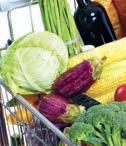



































































































TOURISM LINKAGES NETWORK, A DIVISION OF THE TOURISM ENHANCEMENT FUND AGRICULTURAL SUPPLIERS FOOD SAFETY MANUAL 84 Agrilinkage Exchange (ALEX) is Jamaica's first Agri-Call Centre and digital Agro-trading platform which links farmers to suppliers seamlessly with the main focus on penetrating the hotel and tourism sector. Call us today... AgriLinkages Exchange Agrilinkages.gov.jm 876-970-1451 876-970-0287 876-970-0838 Farmers -Need market for your produce? Suppliers/Hoteliers -what is your demand? DRAFT
NOTES
TOURISM LINKAGES NETWORK, A DIVISION OF THE TOURISM ENHANCEMENT FUND AGRICULTURAL SUPPLIERS FOOD SAFETY MANUAL
85
DRAFT
NOTES
TOURISM LINKAGES NETWORK, A DIVISION OF THE TOURISM ENHANCEMENT FUND AGRICULTURAL SUPPLIERS FOOD SAFETY MANUAL
86 DRAFT
NOTES
TOURISM LINKAGES NETWORK, A DIVISION OF THE TOURISM ENHANCEMENT FUND AGRICULTURAL SUPPLIERS FOOD SAFETY MANUAL
87
DRAFT
Tourism Enhancement Fund, 60 Knutsford Boulevard, Panjam Building, 2nd Floor, Kingston 5, Jamaica W.I.
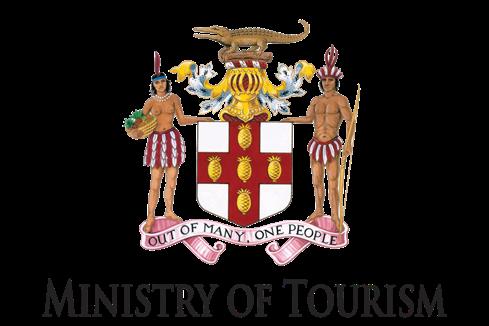


Telephone: (876) 920-4926-30 Fax: (876) 920-4944
E-mail: tourismlinkages@tef.gov.jm Website: www.tef.gov.jm
DRAFT














































































































